Rebuilding a 1910 Mannlicher-Schoenauer
9.5 x 57 mm Sporting Rifle

Rebuilding a 1910 Mannlicher-Schoenauer
|
The Lost MannlicherAlthough the Mannlicher is legendary in sporting history, most of that repute is attributed either specifically to the action designs of Ferdinand Mannlicher and Otto Schoenauer for their smoothness, quickness and reliability or else to the .256 Mannlicher and .256 Mannlicher-Schoenauer cartridges. Less well remembered are the other Mannlicher cartridges, the 9 x 56 mm in the Model 1905, the 8 x 56 mm in the Model 1908 and especially the 9.5 x 57 mm in the Model 1910. All of these were Mannlicher-Schoenauer models with the spool magazine designed by Otto Schoenauer. Most of the better English gunmakers proudly produced sporter versions of the Mannlicher and it was very popular in the early decades of the 20th century. Model 1905 and 1908 carbines appear from time to time on the various gun auctions, most commonly the 1908 Model. I have never seen an example of either of these with a barrel longer than 19.7 inches (500 mm). Possibly they were made, but if so then they are rare indeed. However, I have only encountered a very few examples of the 1910 Model. It is the lost Mannlicher. 
An original Mannlicher-Schoenauer Model 1910 take-down sporting rifle in .375 Rimless Nitro Express (9,5 x 57 mm)The 9.5 x 57 mm Mannlicher-Schoenauer cartridge was Steyr's answer to the development of the .400/.375 Belted Rimless Nitro Express by Holland & Holland in 1905, specifically intended for their sporting rifles based on the Mannlicher-Schoenauer action. There is some indication that the 9.5 x 57 mm Mannlicher-Schoenauer cartridge design was undertaken by Westley Richards with Eley around 1908. Certainly they were the principal original promoter of the cartridge. The 1912 Westley Richards catalog highlights a specially built Mannlicher-Schoenauer takedown rifle with express sights and chambered for this cartridge. A muzzle velocity of 2200 fps is touted and the cartridges are loaded with Westley Richards' proprietary LT capped 270 grain bullets (see the figure below). The Kynoch (Imperial Chemical Industries) 1926 catalog shows two loadings, the slower of which is designated the .375 Rimless Nitro Express, having muzzle velocities of 2100 fps and 2200 fps from a 25 inch barrel with 270 grain bullets. The 9.5 x 57 mm Mannlicher-Schoenauer and the .375 Rimless Nitro Express are in fact the same cartridge, but the latter was the designation of trade (non-proprietary) chamberings. The load difference may have been the consequence of accommodation for tropical temperatures or perhaps for the sight regulation by trade makers. 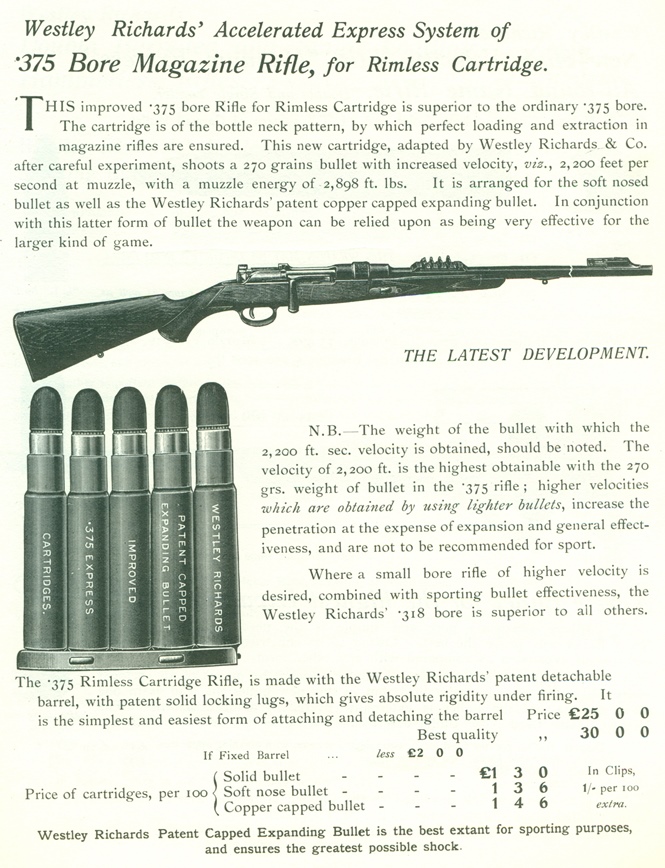
Reproduction of 1912 Westley Richards catalog advertisement for a
| |||||||||||||||||||||||||||||||||||||||||||||||||||||||||||||||||||||||||||||||||||||||||||||||||||||||||||||||||||||||||||||||||||||||||||||||||||||||||||||||||||||||||||||||||||||||||
A Rare FindAs I mentioned, I have seen only a few examples of the 1910 Model on gun auctions and with vintage gun houses. The least expensive was priced at $2600 and not in the best condition. The others were all at or over $3000. All of these rifles had barrels of 22 to 24 inches, unlike the Models 1905 and 1908. So, when I chanced upon an auction on GunBroker for a parts set for a 1910 Mannlicher-Schoenauer for $850, I pounced. When I received the parts, the metal looked pretty good. It was evident that some surface roughness had been masked with a satin blue finish and there were other problems too. The tang was designed to use a factory-installed retractable aperture sight; something I had previously seen on a Jeffery Mannlicher rifle years before. Unfortunately there was something amiss with the parts. It couldn't be made to work with the existing trigger guard and stock bolt. Additionally, the front stock bolt was very loose in the socket, probably due to use as a takedown, which this rifle originally had been. But I think the real reason that I managed to obtain this complete rifle parts set so inexpensively, is that the poor fellow who undertook to restore this rifle before me discovered that nobody out there will make you an inletted stock for this action - nobody other than a custom stockmaker, who would carve it from the blank by hand and charge several thousand dollars. Almost no one has the pattern to make this stock. Whoever disposed of the original gunstock, even if it had been broken in half, doomed that project. | |||||||||||||||||||||||||||||||||||||||||||||||||||||||||||||||||||||||||||||||||||||||||||||||||||||||||||||||||||||||||||||||||||||||||||||||||||||||||||||||||||||||||||||||||||||||||
Building the RifleFortunately for me, I had an amazingly talented brother whose enthusiasm for making things with his hands extends to gunsmithing and stockmaking (to my enduring sorrow, I lost my brother to cancer in 2020). Before he did anything, he made a full-size plan drawing of the rifle and stock as it would look when the project was completed. This enabled him to establish the correct lines for the stock and dimensions for the proper placement of the barrel band in relation to the forearm tip, rear island swivel base, etc. Mechanically, this was probably the most challenging project that my brother has undertaken. What seemed a simple task of restocking a parts set turned into a major gunsmithing project. The first thing that he discovered was that the tang on this rifle had been designed or modified to mate with a piece that enclosed a folding tang sight. This was part of the original takedown mechanism of the rifle. Installing this would have made an awkward wrist on the stock, however, not using it would require modifying the receiver tang because the receiver bolt was designed to screw into the tang sight, not the receiver. Although I originally wanted to use the unique tang sight (I had seen these occasionally before on Steyr Mannlichers), we ultimately decided that its real world utility was limited because it was fixed in elevation and windage and had a very narrow aperture. So, the decision was made to adapt the receiver to a normal rear receiver bolt mounting. However, the receiver tang had been truncated in order to accommodate the tang sight. Working around this situation entailed welding a piece of steel on the underside of the receiver tang which was then drilled and tapped for the receiver bolt. 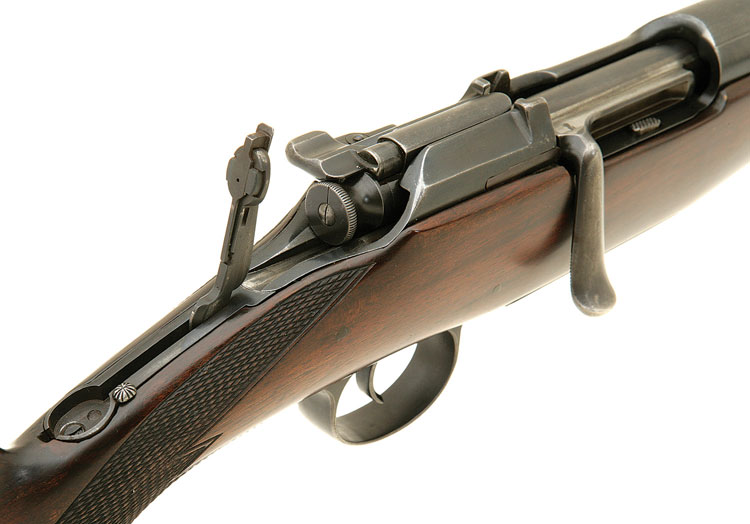
An original tang sight on a Mannlicher-Schoenauer Model 1910He also discovered that the front receiver bolt was so worn that even when fully screwed into the threads it remained loose. The only solution was to make a replacement bolt. My brother was able to determine the thread pitch, which was metric, and purchase a bolt of the appropriate length from a hardware store. He then filed down the hexagonal head of the bolt to make a round head of the proper size and cut a narrow screwdriver slot in the face. A consequence of the custom built bolt was the necessity of a custom built turnscrew to tighten it, so he also made that. Its a nice touch, such as you would have found in a fitted case for a custom built rifle by an English maker. As challenging as that sounds, a greater technical challenge lay in making the stock pattern. Fortunately, my brother retained the pattern that he had previously used to restock my Model 1950 GK Mannlicher-Schoenauer. However, there was a complication with that. The Model 1950 action was lengthened by 1/4 inch to accommodate the 2-1/2 inch case, .30-06 Springfield - .270 Winchester size whereas the original Mannlicher-Schoenauer action was based on the 2 to 2-1/4 inch case length of the Mannlicher and Mauser cartridges. This means that the inletting on the front of the action is 1/4 inch too far forward, including the receiver and barrel inletting. Remember when I stated that no one keeps a pattern for a pre-war Mannlicher-Schoenauer? Only my brother's meticulous efforts and skill made it possible to transform the too long post-war pattern into a pre-war pattern. He fully shaped that pattern, inside and out, to allow the stock blank to be cut to near-final dimensions. When the metalwork and stock pattern were completed, the pattern was sent off to have a blank carved. I had purchased a blank of English walnut from Paul and Sharon Dressel, from whom I had bought some good blanks in the past. My brother and I agonized over the blank selection because the grain flow had to compliment the stock shape which was to have a lot of drop at the heel, unlike modern stocks which tend to be dead straight. This makes finding a good blank more difficult because they tend to be cut with modern rifles in mind. 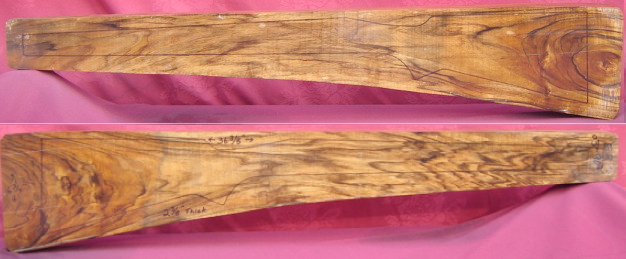
The English walnut blank from Paul & Sharon Dressel that was chosen for the gunstockWhen the carved blank returned from duplication my brother was not happy with the manner in which it had been done. He had shaped that pattern to final dimensions and explicitly stipulated that it be cut tight. In the past, this duplicator had followed that guidance with great results. Instead, this time a lot of wood had been left. He essentially had to re-shape the entire stock all over again. He then discovered that this was the hardest piece of wood that he had ever worked. He spent more time inletting and shaping this stock than any he has previously made and swore that he would never do another Mannlicher. An authentic S. W. Silver brand rubber pad in "best London orange" color, replicating the exact original style and color of pad used by British gunmakers in the late 19th and early 20th centuries, was fitted, shaped and polished. Period correct European style sling swivels were installed on the barrel and the stock. There is an English style steel grip cap by Dressel and ebony fore-end tip and crossbolt plugs. 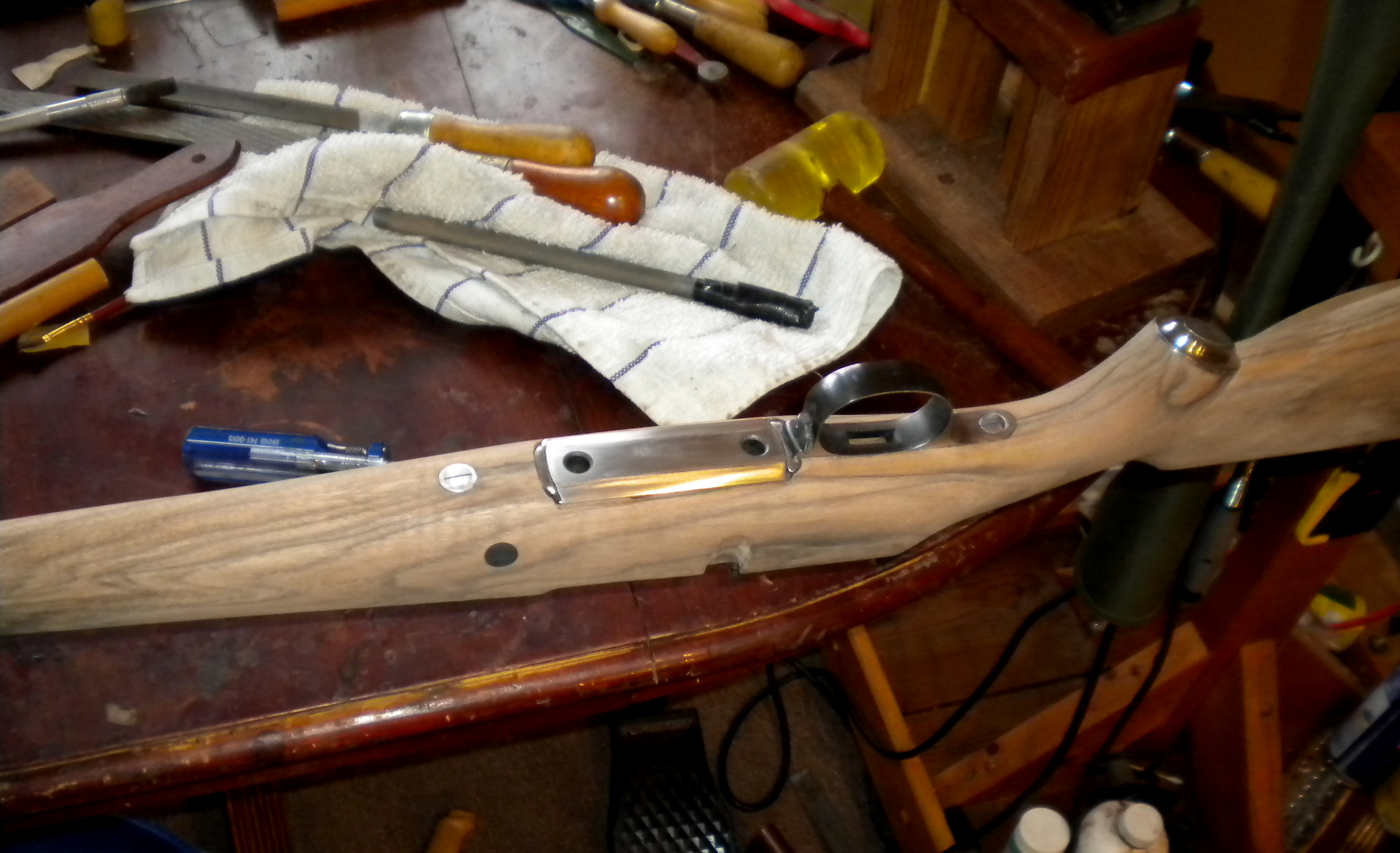
The process of fitting the gunstock to the action nears completion; Note the clocking of the action bolts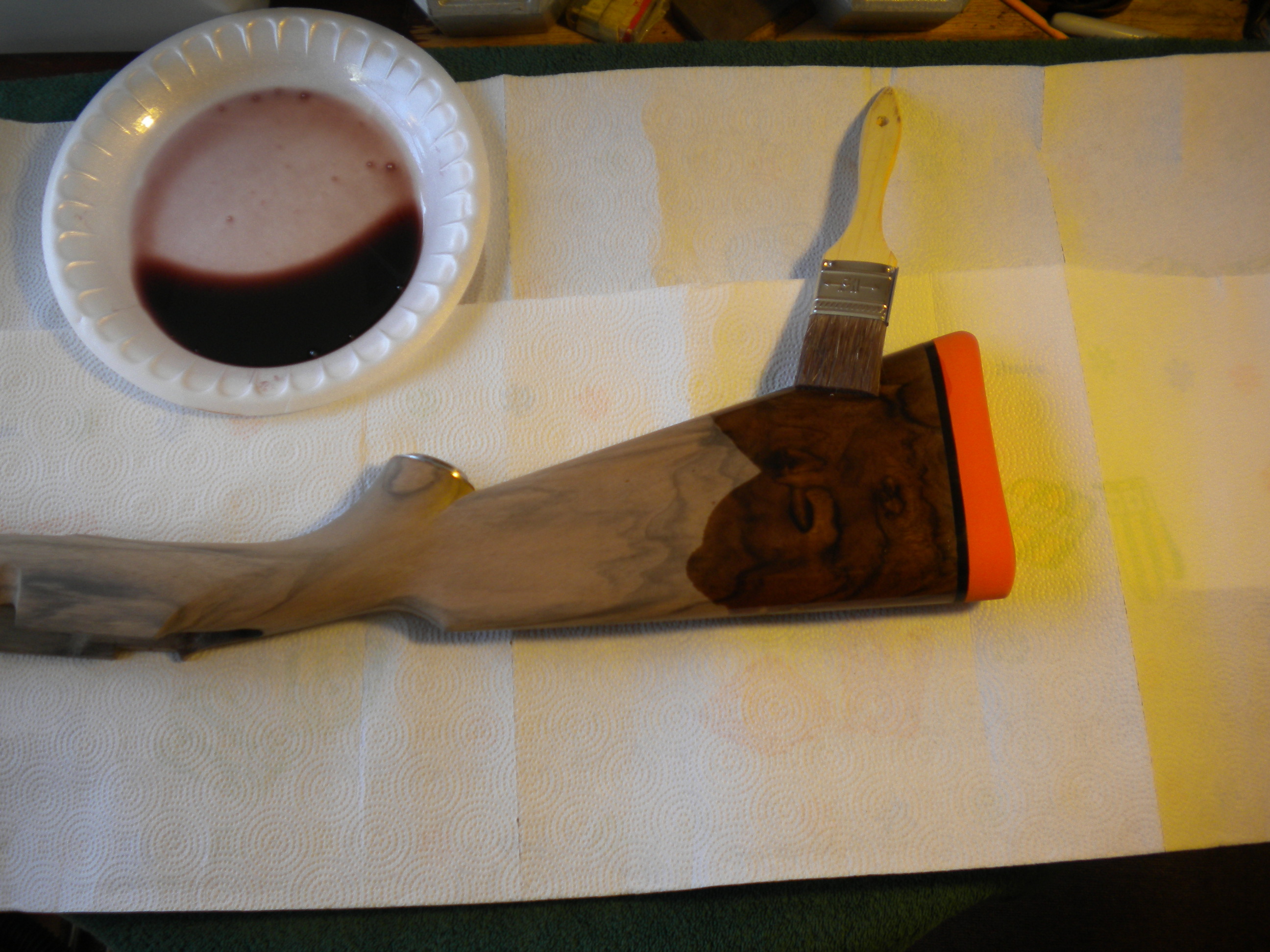
My brother begins to apply his secret blend of gunstock oil for a hand-rubbed finishTo compliment the European style sling swivels, my brother fashioned a sling with adjustable loops using a copper rivet and sliding band to positively secure each end of the strap. 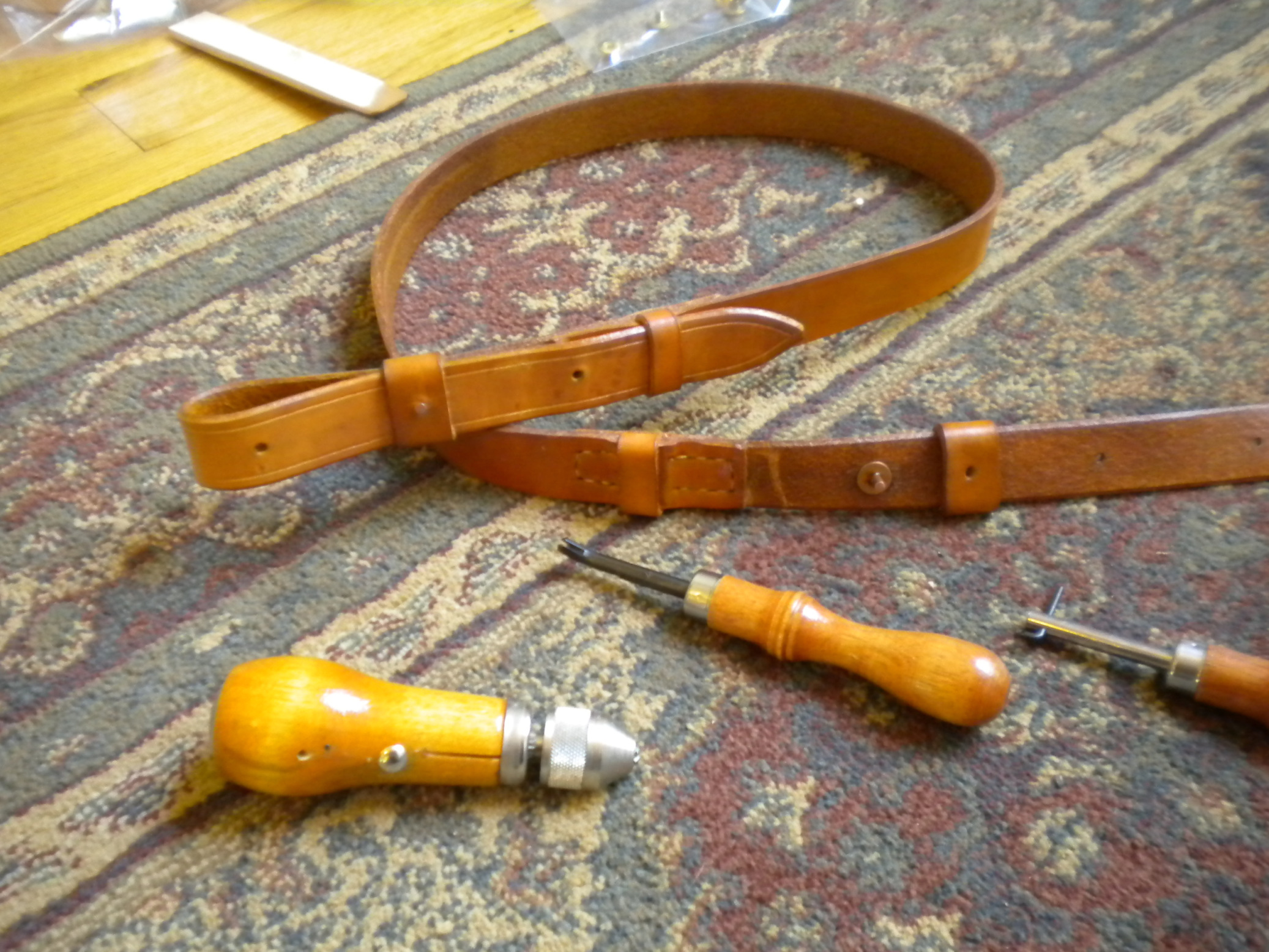
A hand cut and sewn rifle sling made by my brother with traditional loop fastenersI got an early look at the rifle in the Spring of 2013, when my brother asked me to bring down some handloads so that we could do a test shoot and check the sights before he finished and rust blued the metal. The sights needed little adjustment and the old barrel printed a very respectable 2 MOA group at 100 yards, which is not bad at all using iron sights and a starting load without accuracy tuning. 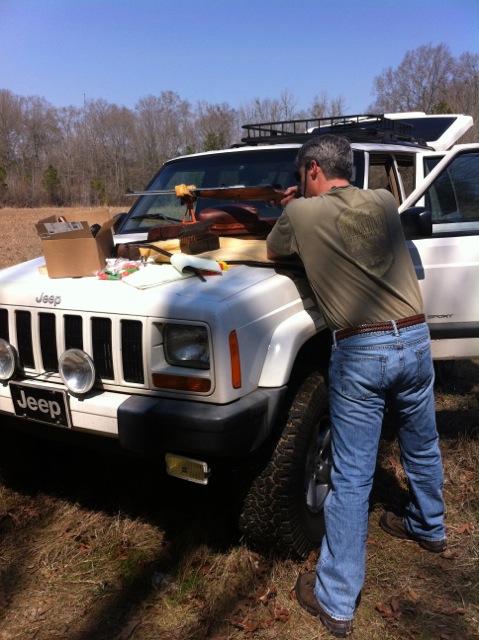
I test fire the rifle before final finishing is performedThe checkering was performed by Tim Smith-Lyon (Classic Checkering), in the classic English style. The point pattern follows a straight line on the rear of the wrist to meet in a point over the top of the wrist. This is very characteristic of English rifles. | |||||||||||||||||||||||||||||||||||||||||||||||||||||||||||||||||||||||||||||||||||||||||||||||||||||||||||||||||||||||||||||||||||||||||||||||||||||||||||||||||||||||||||||||||||||||||
The Completed Rifle
Right-side profile view of the finished Model 1910 Mannlicher-Schoenauer
Left-side profile view of the finished Model 1910 Mannlicher-Schoenauer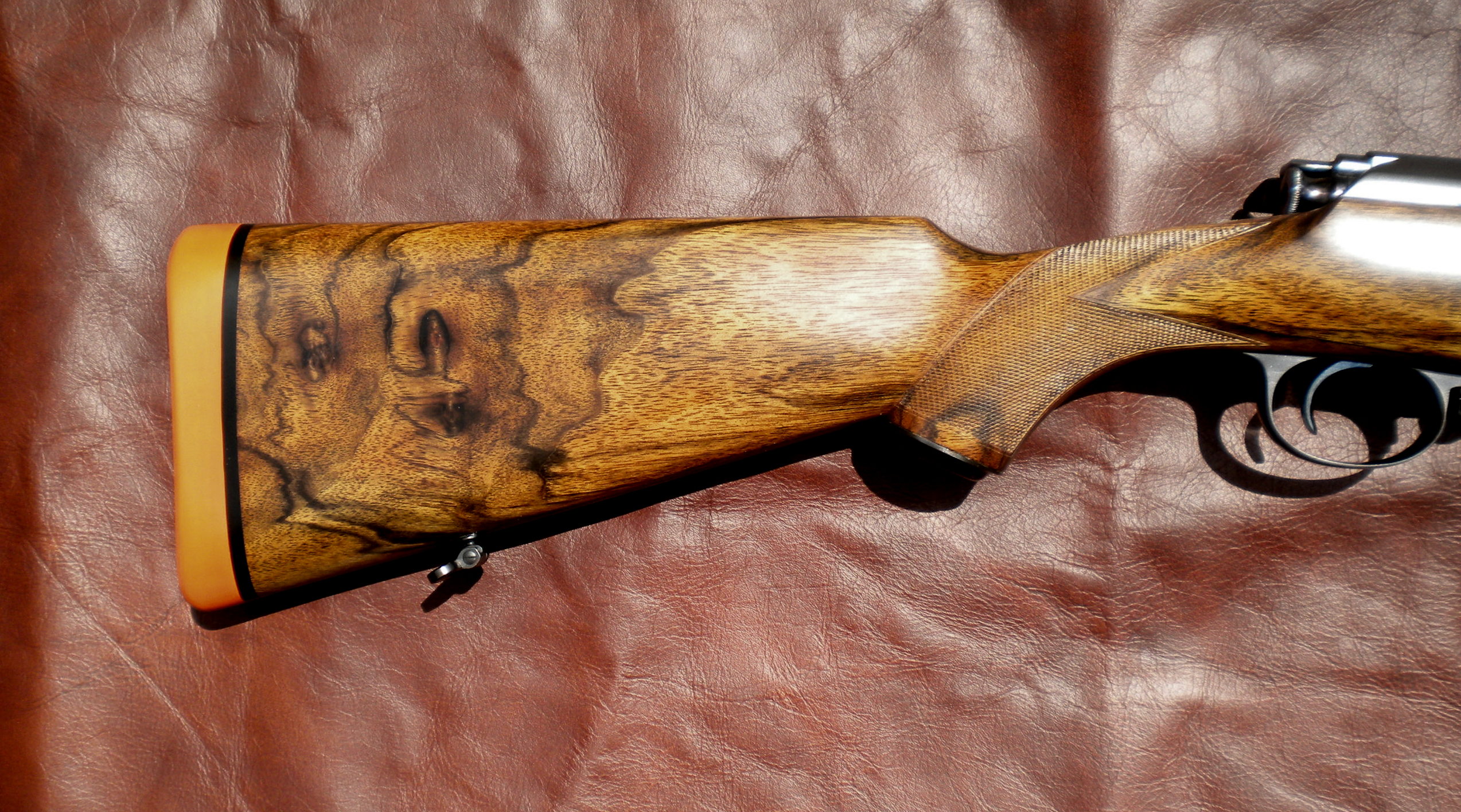
Close-up view of the right side of the stock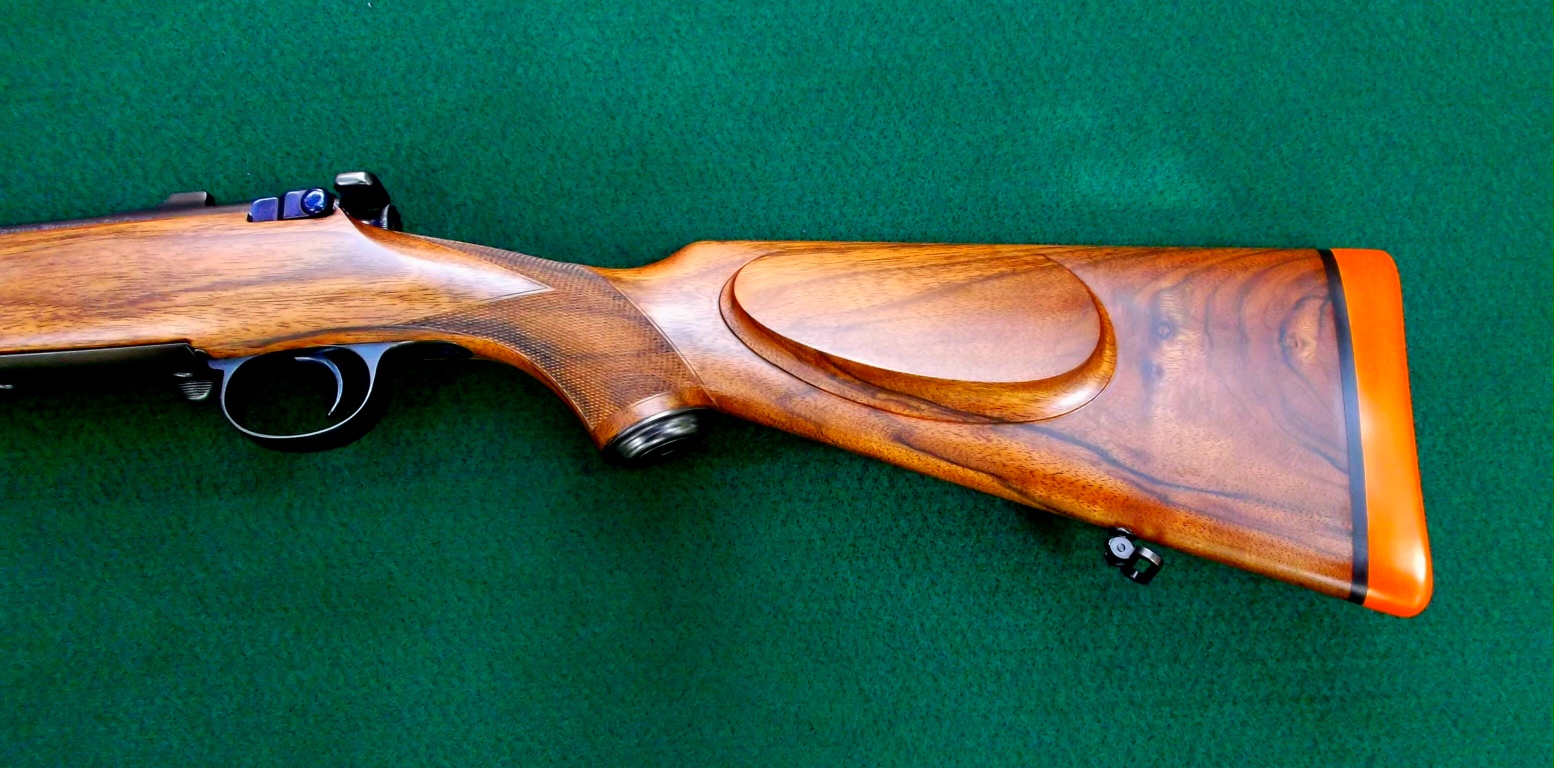
Close-up view of the left side of the stock and the traditional pancake cheekpiece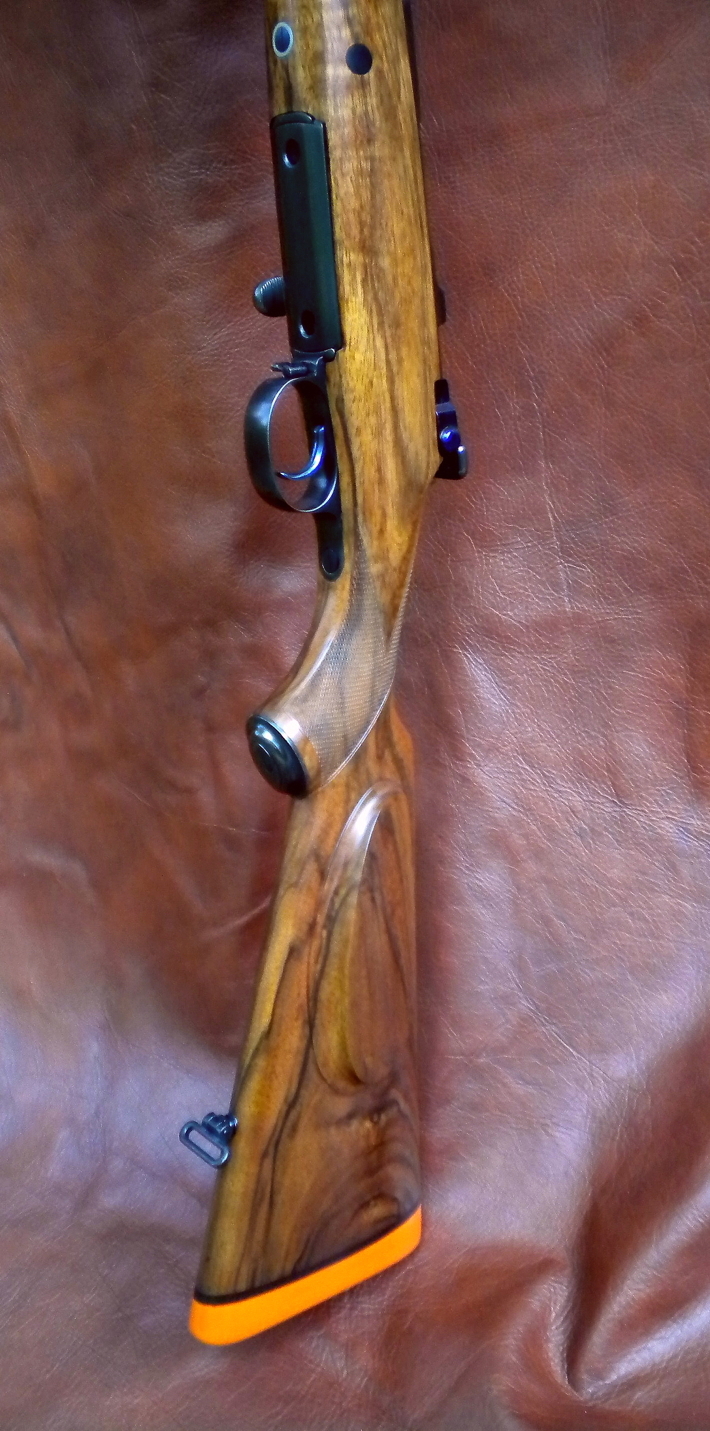
View of the left side of the stock
Detail view of the classic English style checkering on the wrist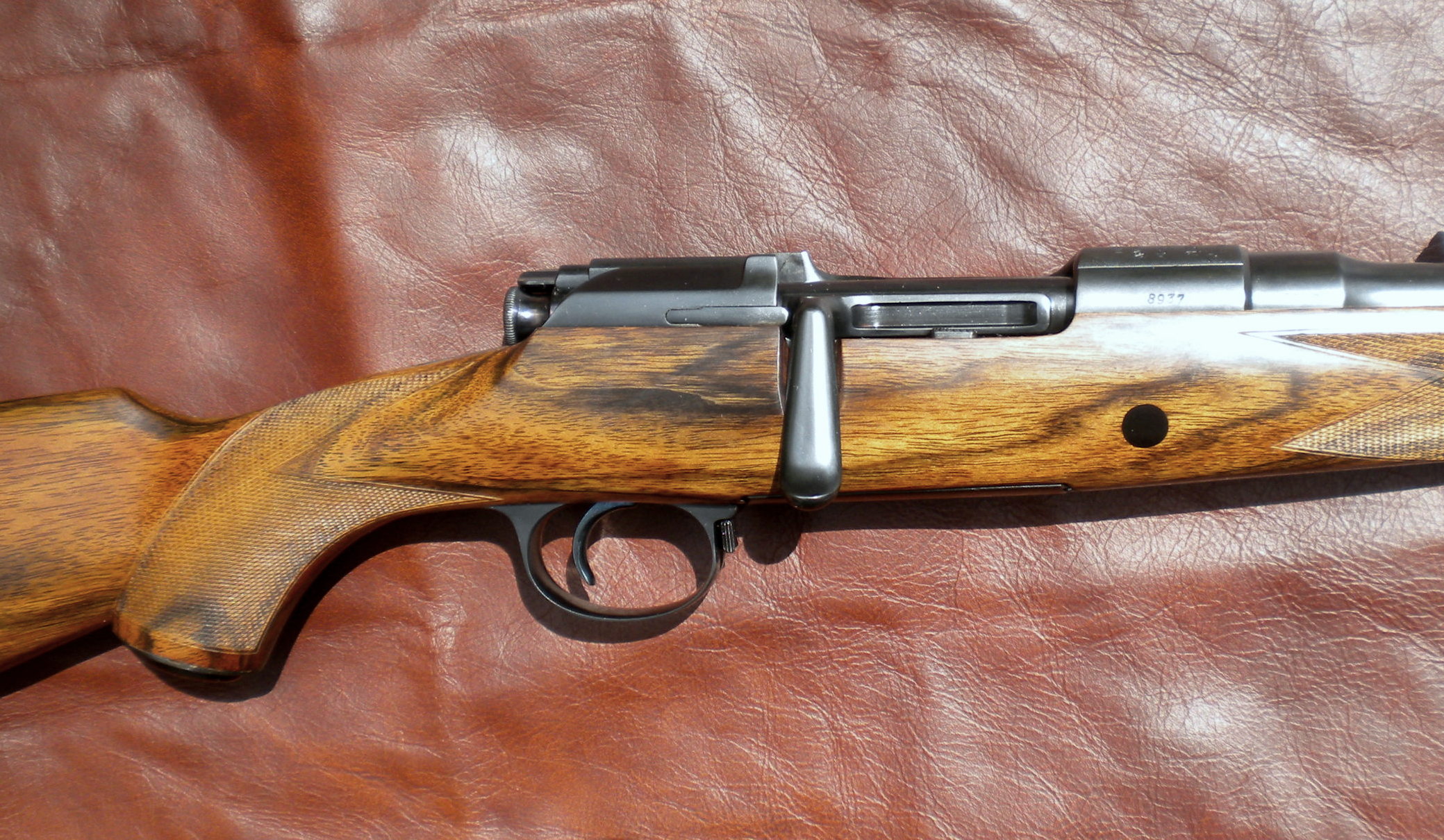
Close-up view of the right side of the action and wrist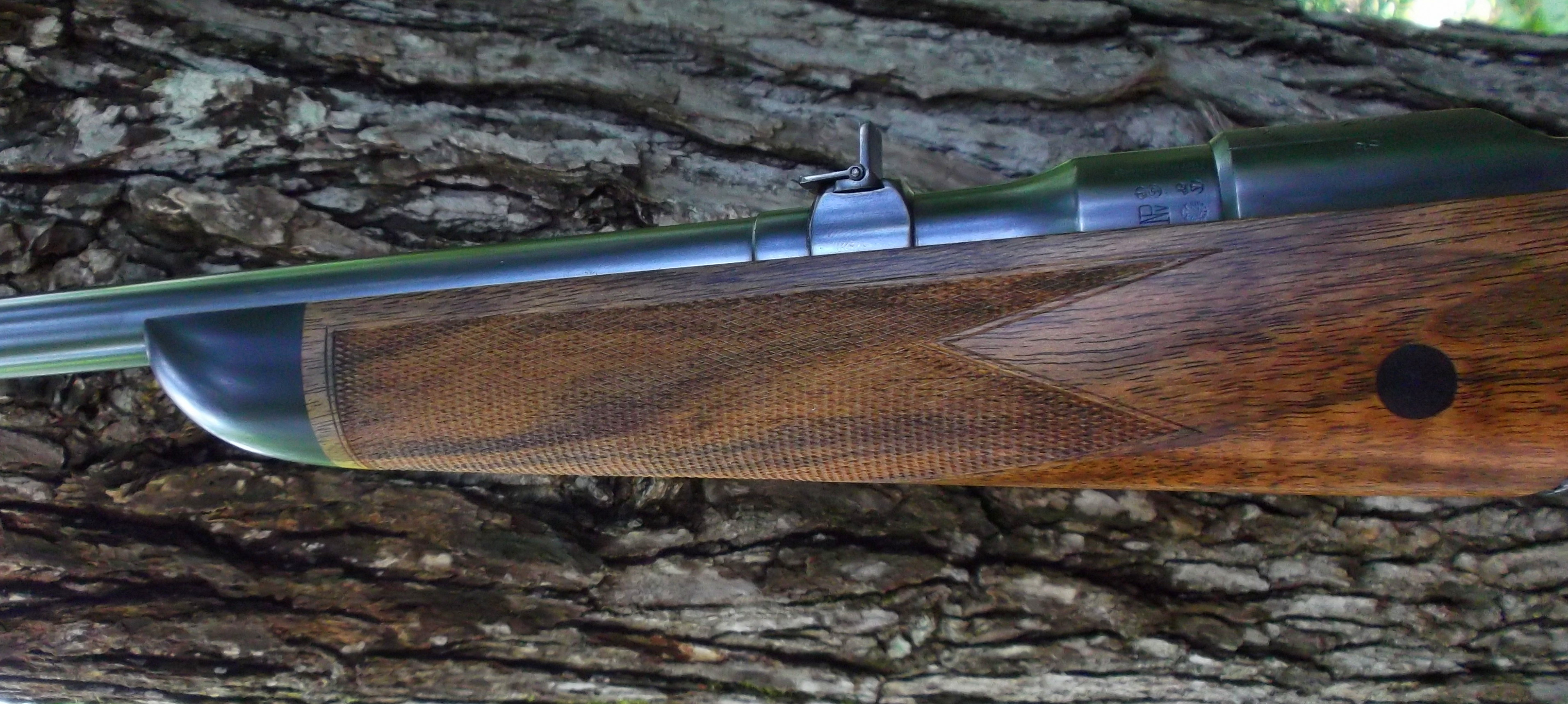
Close-up view of the checkering on the forearm
Detail view of the underside of the rifle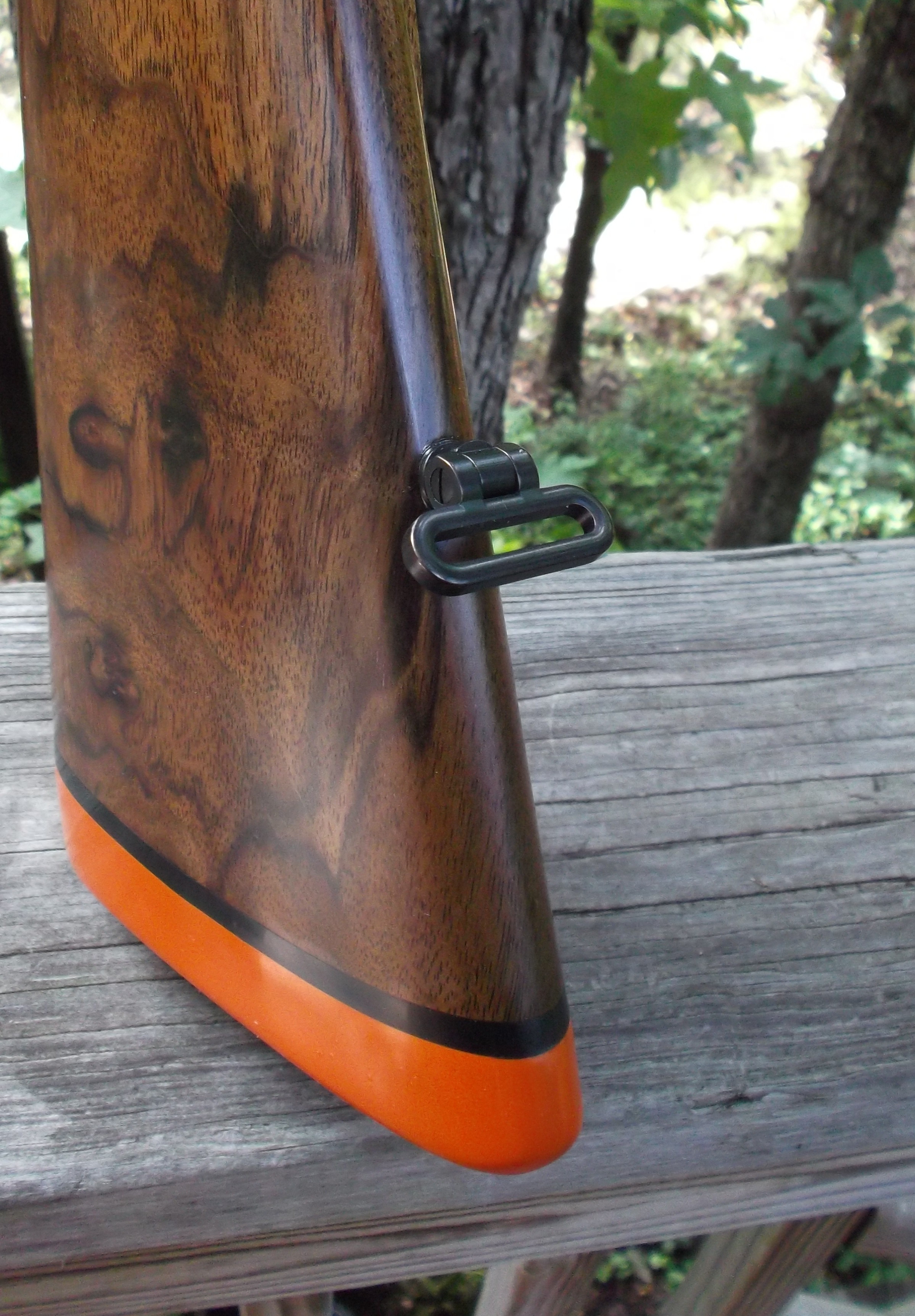
Close up view of the European style sling swivel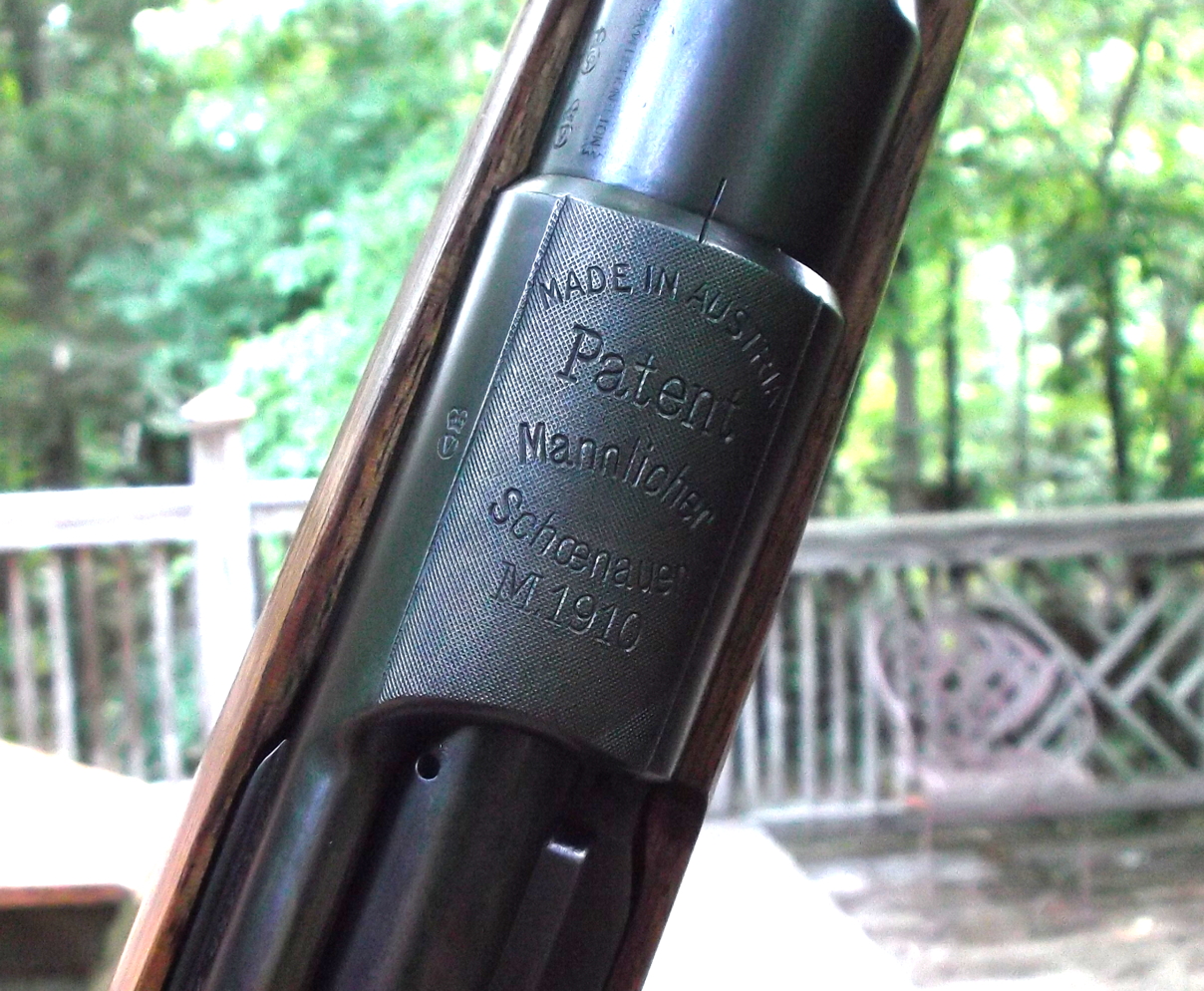
Close up view of the Mannlicher-Schoenauer Model 1910 marking on the receiver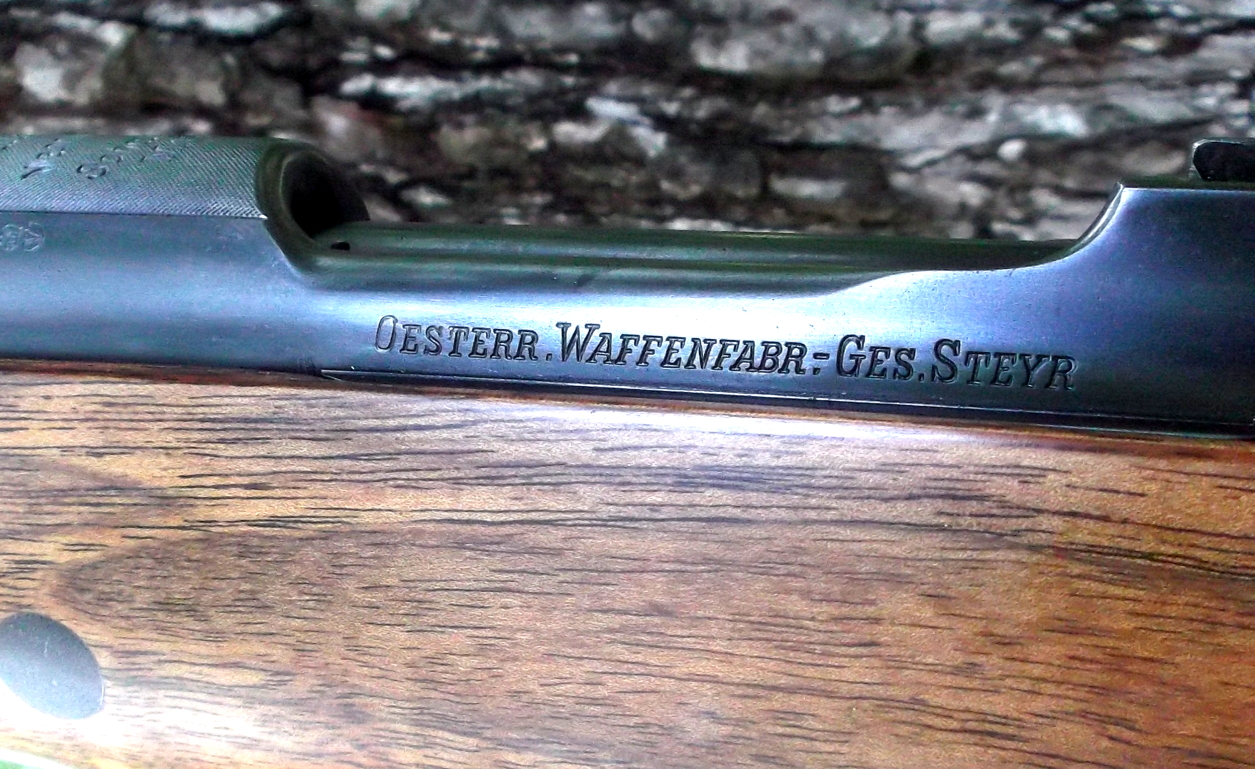
Receiver marking for "Austrian Arms Manufacturer-Association, Steyr"This abbreviated receiver marking, "Oesterreichischer Waffenfabrik-Gesellschaft, Steyr" translated means "Austrian Arms Manufacturer-Association, Steyr". It was an arms manufacturing collective originally created in 1869 in the town of Steyr, and evolved out of the prior Werndl arms company. All of the original classic Mannlichers were designed and built by the OWG. In 1926, the name changed to Steyr-Werke, AG and in 1934 it became Steyr-Daimler-Puch, AG, which is the marking found on the post-war models. 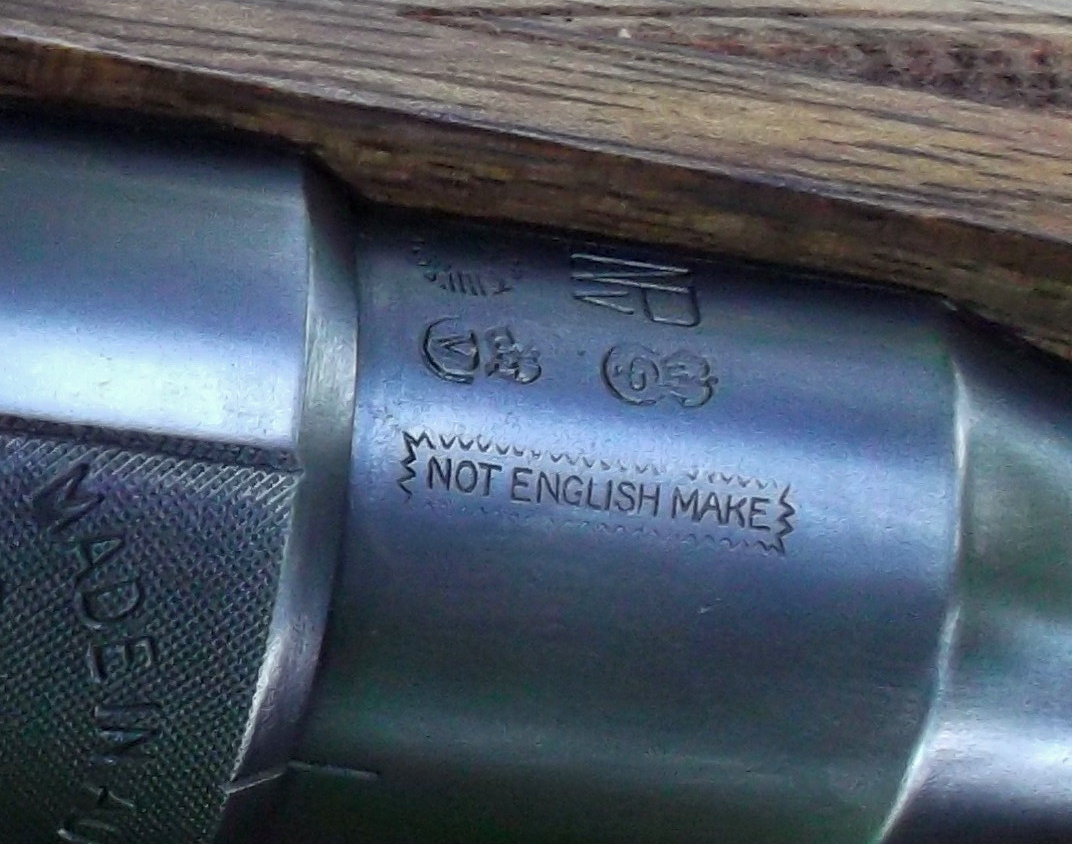
A very patriotic British import stamp | |||||||||||||||||||||||||||||||||||||||||||||||||||||||||||||||||||||||||||||||||||||||||||||||||||||||||||||||||||||||||||||||||||||||||||||||||||||||||||||||||||||||||||||||||||||||||
Load DevelopmentBrassFortuitously, considering that this cartridge is over 100 years old and hasn't been commercially loaded over most of that time, obtaining brass is not a problem. Sure, you can buy the properly headstamped brass from Bertram, but its expensive. An equally functional and far less costly answer is to buy 9.3 x 57 mm brass from Norma or Lapua. A quick pass through the full-length or neck sizing die will effortlessly form the neck to the proper diameter. If you really want to be frugal you can neck up 8 x 57 mm Mauser brass. That is a bit more of a stretch to the neck going from .323 to .375 caliber, but should not be a problem. Having said all of the above, it's worth noting that the first time that you fire brass from any of the Mauser cartridges you will fireform the shoulder a bit forward and open it up. My fireformed brass has a shoulder diameter of 0.460 inches. That compares with 0.430 for the 9.3 x 57 mm Mauser. It is a meaningful increase. In conjuction, these dimensional differences give the 9.5 x 57 mm Mannlicher-Schoenauer a slightly larger case volume than the 9.3 x 57 mm Mauser. The disappointing thing that I have also noted is that the Norma brass I purchased has a base diameter of only 0.465 inches, not the correct 0.470 inches. Five-thousandths is a significant size difference. I've seen this situation with other brass lately and I wonder if it's a conscious decision by ammunition manufacturers to ensure reliable feeding of their own ammunition, without regard to the case life concerns of handloaders. With top loads I get a bulge where the base thins into the body. So, Bertram brass may be not such a bad deal after all, if it's of the correct base dimension and will last a lot longer. After my experiences with initial load development and especially after trying some Kynoch factory loads in my rifle (described in detail hereafter), I decided to seek a better cartridge case. Reviewing the dimensions of what was available, I settled on the 7.7 x 58 mm Japanese as the most suitable case. It has a base diameter of 0.470 inches, which is still slightly shy of of the 0.473 inches that would perfectly fit the chamber, but a big improvement over 0.465 inches. Despite the excessive length, they chambered fine. BulletsThis is a smallish cartridge and not well suited to the heaviest bullets typically used with the big .375 caliber magnums. Here again, though, we are in luck. Since there are far more magnum .375s in circulation than there are hunters actually using them for dangerous game hunting (or willing to endure the recoil of full power loads), there are a fair number of alternatives in the lighter bullet weights to choose among. There are also bullets for the .375 Winchester and .38-55 Winchester that are designed to perform at impact velocities well under 2000 fps. The 9.5 x 57 mm was originally designed for a 270 grain bullet, but with today's superior metallurgy, a bullet weighing 250 grains or even as light as 235 grains can be an outstanding performer. An ideal bullet for this cartridge would have been the lamentably discontinued Hornady 270 grain Interlock roundnose, but Hawk makes an excellent Round Tip (0.035 jacket) bullet and Woodleigh makes a bonded Weldcore 270 grain roundnose or Protected Point that would be outstanding at this velocity. For use in my load development, I had a box of an old style Woodleigh SP (W43) semi-spitzers that are no longer available, but the loads should be applicable to the current styles. Nosler makes a 260 grain Accubond boat-tail spire point that may be a bit too long for such a small case but would help extend the reach. The old, now discontinued, Nosler Ballistic Tip of identical design (apart from not being bonded) would also be a very good bullet if you could locate any, but the Accubond is better, albeit more expensive. The Nosler 260 grain Partition is a semi-spitzer nose that would perhaps be a better fit in the case and provide great performance. In today's premium bullet market, Nosler Partitions have become a bargain and in the medium bores they are excellent performers. North Fork Technologies and Swift make 250 grain heavy-jacketed bonded core bullets that would likely offer the ultimate balance of velocity, penetration and cavitation for hunting big game. Both of these makers produce 270 grain bullets of the same form, however I do not believe that the added weight is worthwhile given the robust construction; it is better to gain the modest velocity increase resulting from the shorter copper shank. On the lightest end of the spectrum, there are 235 grain bullets from Speer that are perfectly suitable for any deer and another Woodleigh Weldcore Protected Point that may be a contender for the best all-around bullet in this cartridge, owing to its bonded construction and the flat trajectory it permits. Additionally, there is the Barnes TSX that likely would also be a strong contender for the best all-around bullet since it should provide deep penetration with a very good wound channel in this caliber. Of the monolithic bullets, this is going to be the best weight because it will not be excessively long and allow higher velocities for reliable expansion. Finally, at this muzzle velocity one must seriously consider cast bullets. You can create full power loads with cast bullets in this cartridge. You can also go up to a 300+ grain bullet at a realistic 1950 fps and still get excellent bullet expansion and deep penetration. 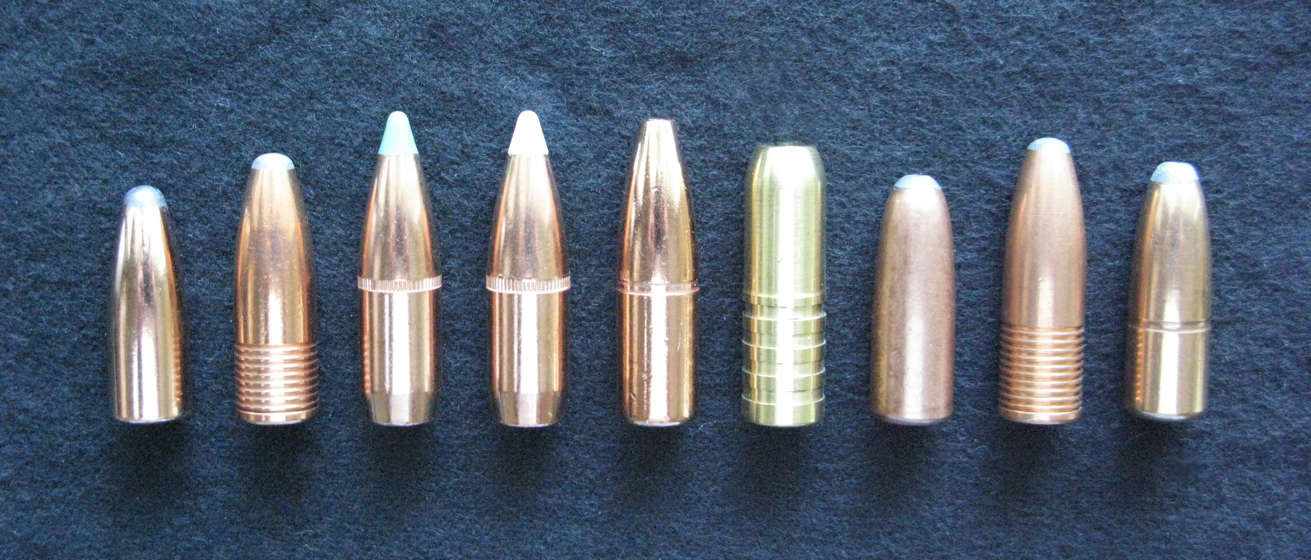
An array of excellent bullets: (L-R) 235 grain Speer Hot Cor SP, 250 grain North Fork Technologies, 260 grain Nosler Ballistic Tip (discontinued), 260 grain Nosler Accubond, 270 grain Barnes X-Bullet (old style), 270 grain Barnes Banded Solid FN, 270 grain Hawk RT (0.035 in), 270 grain North Fork Technologies, 270 grain Woodleigh Weldcore SP (discontinued)PropellantThis medium capacity cartridge, with its large diameter neck, wants a medium burning rate powder; propellants such as Hodgdon H-4895 (ADI AR2206H), Varget (ADI AR2208), IMR-4064, IMR-4320, Accurate A-2495 and A-2520, Alliant Reloder-15 (Norma 203-B) and Vihta Vuori N-140 are ideal. The burn rate of early Cordite was similar to modern medium-fast burn rate rifle propellants, in particular IMR-3031 is often cited as having a very comparable density and burn rate to the grade of Cordite used in small-bore cartridges. Standard loads for the .375 Rimless Nitro Express and 9.5 x 57 mm were 43 or 45 grains for 2100 or 2200 fps. Various sources indicate a maximum muzzle velocity of 2250 fps is possible with this bullet weight and 2400 fps with a 235 grain bullet. The Powley Computer supports these assertions. The 1910 Mannlicher-Schoenauer action should by design be able to handle the same pressures as the .30-06 Springfield or .270 Winchester at 60,000 psi maximum average pressure, but downloading slightly from this level to 56,000 psi is prudent and more historically correct. Loading NotesLoad data are hard to come by. I used some 9 x 57 mm Mauser data from ADI, 9.3 x 57 mm Mauser data from Norma and Vihta Vuori and 358 Winchester data from various sources as a starting point. Any data for the 9.3 x 57 mm cartridge would be perfect since the cartridge is virtually identical and the bullet weights are very similar, but that too is hard to come by. Norma provides data on the 9.3 x 57 mm at this link: http://www.norma.cc/en/Ammunition-Academy/Loading-Data/93x57/. There was an old article, entitled The Forgotten 9.3x57mm Mauser and authored by by Dieter Sturm, that appeared in either Handloader or Rifle magazine some years ago which contains some useful data. Another article by Ken Waters in the same venue called The .375 Express describes the creation of a wildcat cartridge with dimensions very similar to the 9.5 x 57 mm Mannlicher-Schoenauer. In addition, the .375 JDJ is very dimensionally and ballistically similar to the 9.5 x 57 mm Mannlicher-Schoenauer. Any data for the .375 JDJ will work for the 9.5 x 57 mm and is available from Hodgdon, Hornady, Accurate (Reloading Manual Number Two) and of course SSK Industries. All of these sources offer corroboration of the best performance with medium burn rate propellants and suggest consistent loads. Looking at the data presented below, you will immediately notice that I exceed the loads shown in some sources. If you consult some of the references I allude to, you will also discover quite a wide variation in the recommended maximum loads. In defense of my pushing beyond (for instance) the N-203B (aka Reloder-15) maximum load in the Norma data for the 9.3 x 57 mm Mauser, I offer these arguments:
Muzzle velocities in my testing are slightly below the historical benchmarks and reported performance by various sources. The Cordite conversion with Varget was close, within 50 to 100 fps of expected values. Switching to the faster end of the propellant spectrum with IMR-3031, the results were (perhaps predictably) not as impressive. Despite the oft-touted comparison to Cordite, IMR-3031 did not deliver muzzle velocities anywhere near 2150 fps with 43 or 45 grains, falling roughly 275 fps below with the higher load. Eventually, I did what I perhaps ought to have done in the beginning: I slugged the bore. I measured the lands to have a diameter of an expected .366 caliber, however the groove depth measured a startling .381 caliber in the 4-groove rifling. Interestingly, that is only 0.002 inches over what CIP allows. From an internal ballistic standpoint, there is legitimacy to the idea of velocity loss from an oversized bore. I did a little looking around and turned up some information that suggested pressure losses on the order of 20% would be realistic for a gap of six-thousandths. Using a spreadsheet I was able to easily account for the velocities that I was seeing. I am reasonably satisfied that this oversized bore explains the performance difference relative to historical loads. And I do not think it is the result of a worn bore - I think the rifle was manufactured this way (if the grooves were worn deep I would expect the lands to be unusually large as well). There was an episode in rifle design evolution in which the ordnance experts and the manufacturers experimented with enlarging the groove depth as a means of mitigating the fouling that was occurring with early cupro-nickel jacketed bullets and the new nitrocellulose propellants. That is allegedly why the 8 x 57 mm Mauser went from .318 to .323 caliber. Regardless, it is the constraint that I have to live with. Despite this situation, the rifle is quite accurate with .375 caliber bullets. It's always useful to compare with factory loads when moving into unknown territory in reloading, so I purchased a 5 round package of Kynoch cartridges for the princely sum of $35. These have a claimed muzzle velocity of 2150 fps from a 25 inch barrel at 17.5 tons per square inch (44,400 psi) of pressure. Somewhat to my surprise, they achieved a very repeatable 2131 fps from my rifle, very close to the quoted performance from a 25 inch barrel in my 23.6 inch barrel. This confirms my belief that historical performance is achievable in this rifle with normal loads. I am skeptical about the 17.5 tons of pressure claim because the cartridges that I fired experienced a case head rupture and split necks. It's hard to think that can happen at only 44,400 psi; however, I do not think the pressure was excessive, in the usual sense, it was probably in the mid-50,000s psi range, but saying that dimensions on the chamber of my rifle are generous is being generous, and in that sense the pressure was excessive, for this rifle and these cases. All of my loads anywhere near maximum cause the case to expand to more than 0.470 diameter; however, in none of these does the actual case head expand at all, remaining 0.465 inches. It is just a mismatch between the brass and chamber dimensions; both the main chamber and neck / throat region are oversized. This case ruptured at 0.474 inches. Look below at the reprint of a vintage Eley drawing for manufacture of the 9.5 x 57 mm Mannlicher-Schoenauer. Add 0.005 inches in diameter to those case dimensions all the way up and you have my chamber. Exploring more deeply, I pulled a bullet on a remaining cartridge and weighed the charge. It worked out to 48.5 grains of a short grained extruded powder, which means something at least as fast as IMR-3031. 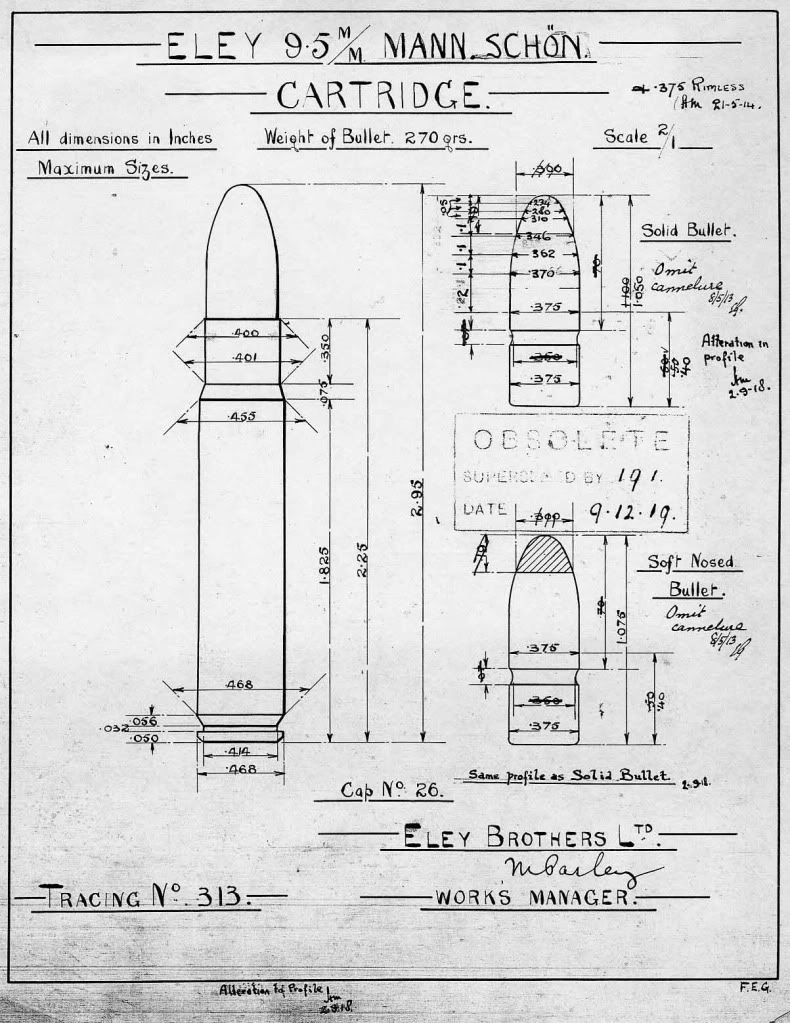
Eley Cartridge Drawing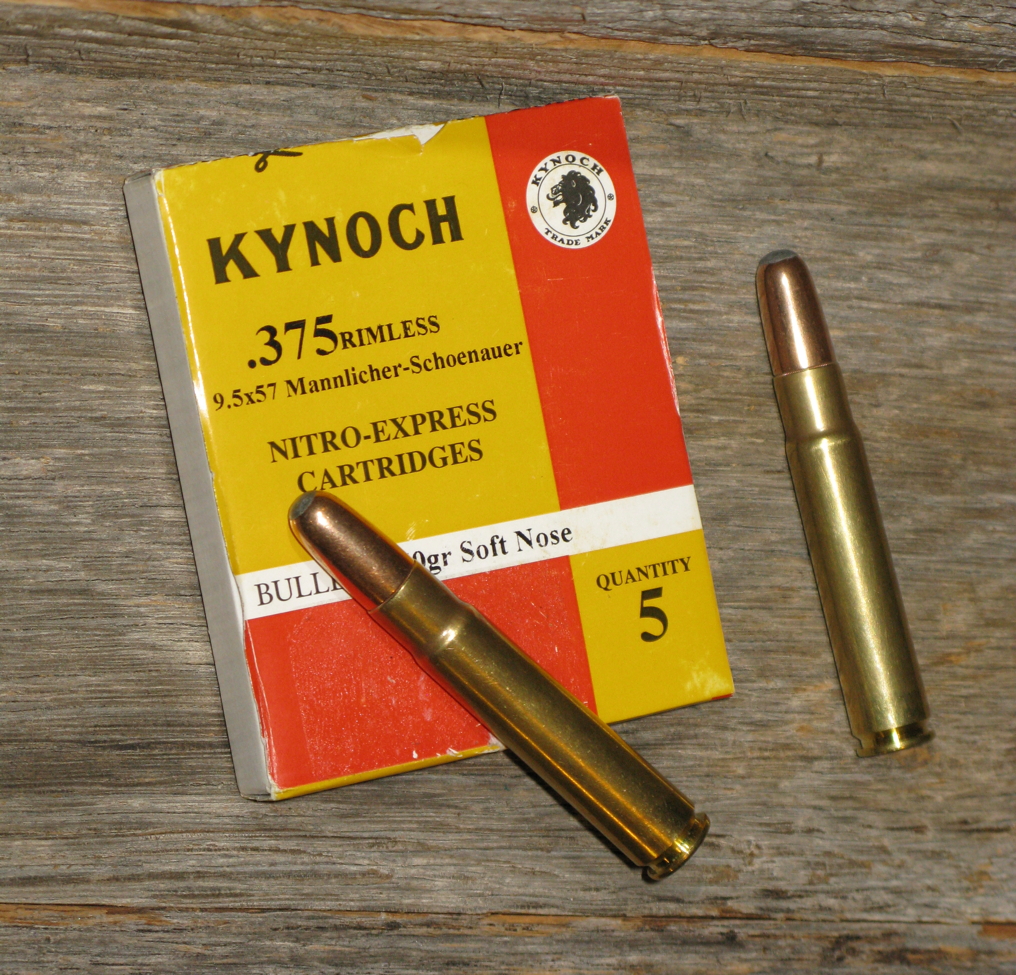
Current production Kynoch ammunition for the 9.5 x 57 mm Mannlicher-Schoenauer (aka .375 Rimless Nitro Express)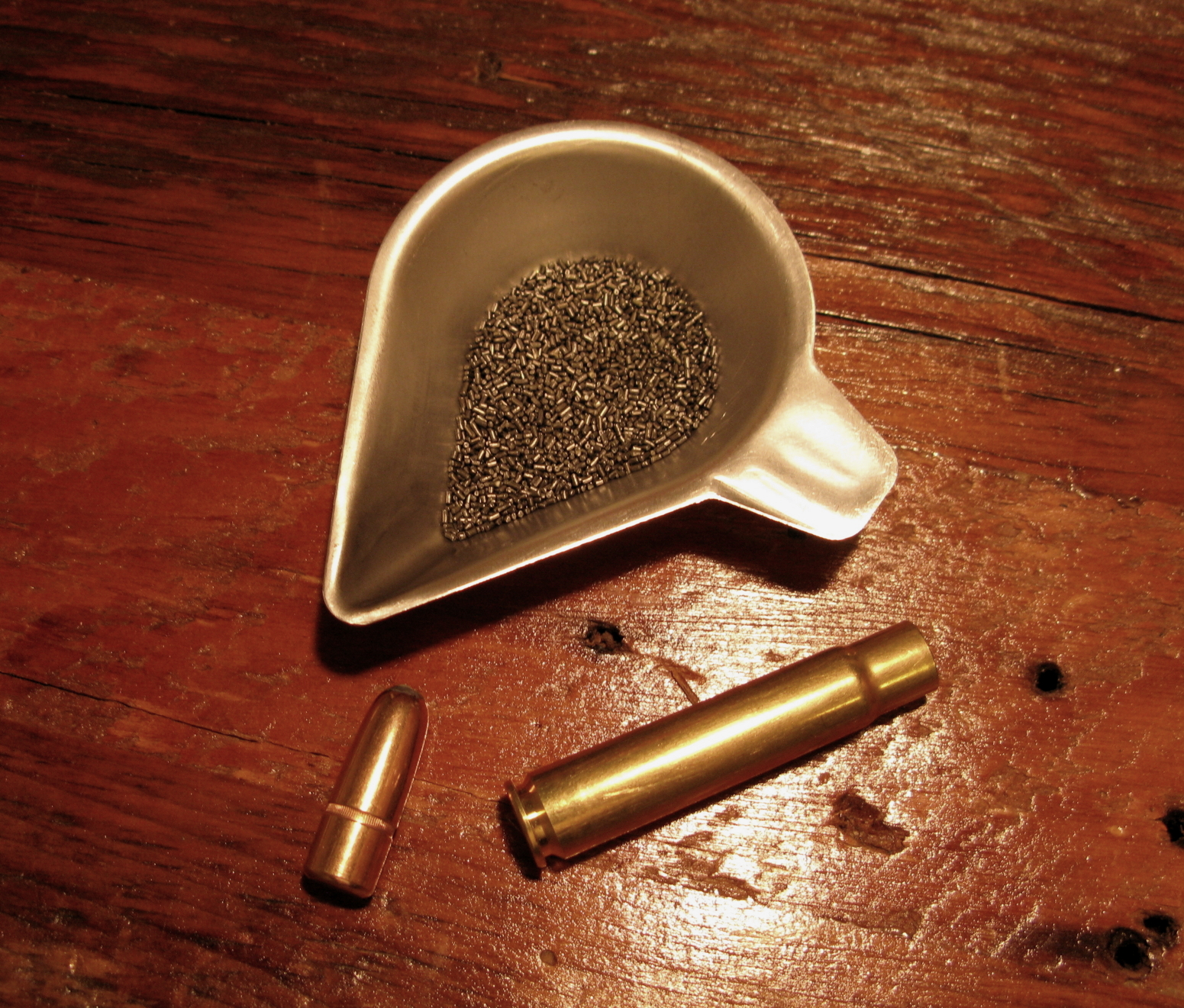
Kynoch load with 48.5 grains of propellant and Woodleigh 270 gr RN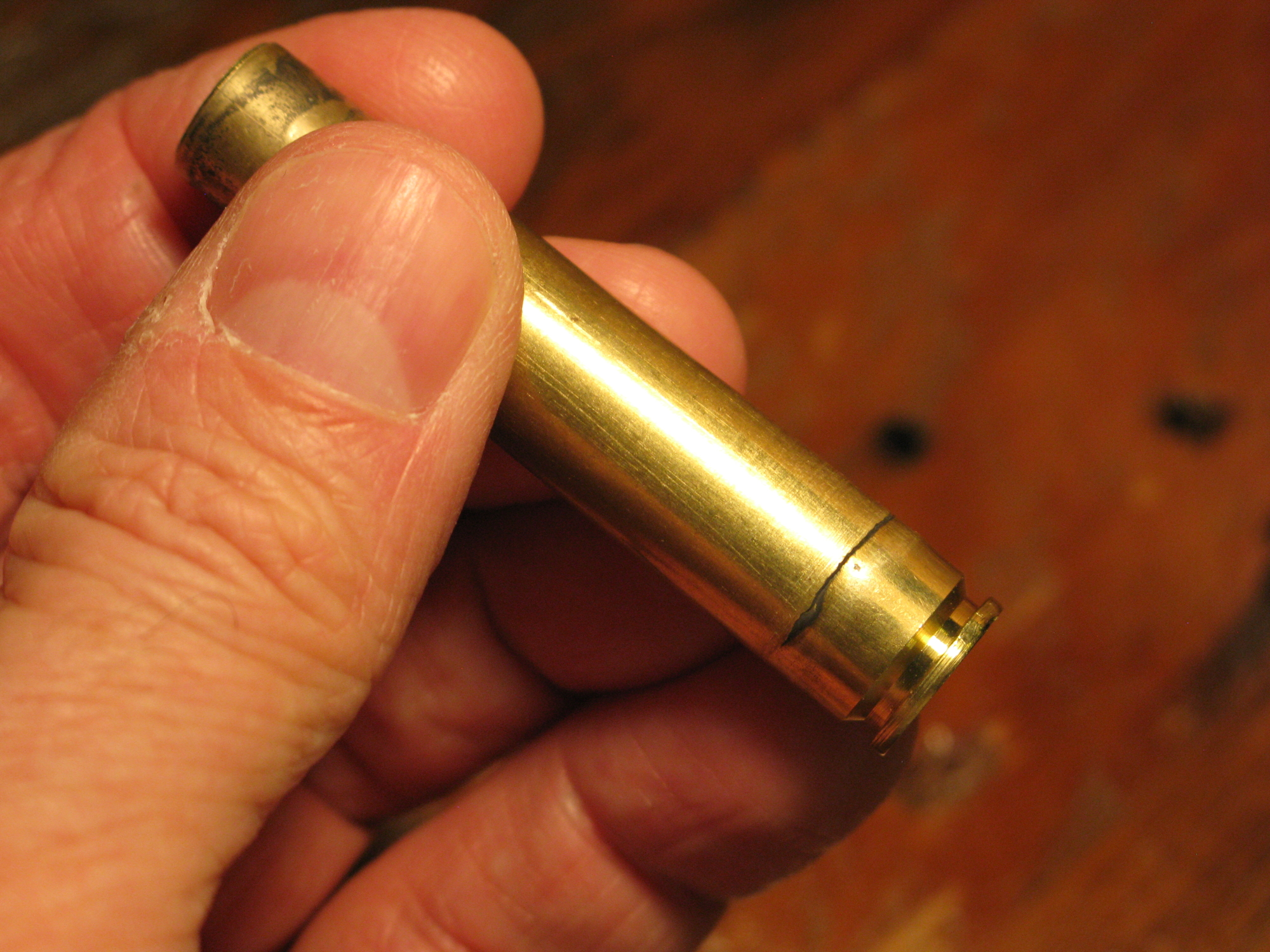
Case head rupture in factory Kynoch loadClearly, with the Norma brass "normal" loads for this rifle must be somewhat below the maximum and even at that the brass life won't be good. Given this circumstance, I was moved to not only consider cast bullets but to re-envision the performance baseline for this rifle. Typically, a cast bullet will deliver a meaningful improvement in muzzle velocity relative to a jacketed bullet with the same load, due to its lower bore friction. But there is another advantage. Cast bullets come into their own in terms of terminal performance at the impact velocity range where jacketed bullets tend to be on the ragged edge of failing to expand at all, between 1800 and 2100 fps. Since this, on the upper side, is the predicted muzzle velocity for the 270 grain bullet in this cartridge, cast bullets make good sense for the 9.5 x 57 mm for any loads other than the 235 grain class. You really give up nothing and may gain downrange effectiveness beyond the point where a jacketed bullet would fail. In my rifle, the 235 grainer is scooting along barely faster than the 270 grain bullet, so going light is not much of an advantage. Going heavier, on the other hand... This is where re-envisioning the performance can get interesting. Period loads did sometimes include a 300 or 320 grain bullet in the .375 Nitro Express and its rimless sibling. This moves into the territory of the much hailed .400/.350 Rigby and .400/.360 Westley Richards cartridges. Granted, they were .358 or .360 caliber, so they had theoretically better penetration, but that is more a function of the bullet construction than anything else, and bigger diameter has a quality all its own. So, I began to imagine a load using a 300 grain flat-nosed cast bullet exiting the muzzle at 1900 to 1950 fps as a goal. Originally, I designed a bullet mold to have a long ogive and a round nose for better ballistic coefficient, rather than a bround flat nose, because I intend that this bullet will depend on its relatively high velocity and expansion for effectiveness on game. The noses of hard cast bullets can be easily annealed in such a manner that retains the hardness of the rear shank of the bullet for proper behavior in the bore, but now having a nose portion soft enough to expand easily. However, the moldmaker declined to cut the mold, citing creative differences and technical difficulties with machining a long ogive, typical of what is desired for a high-velocity bullet in a bolt action or single-shot rifle. It was then that I discovered Accurate Molds, which has a vast catalog of designs and is willing to make custom changes to any of these or cut one of your own design. I chose this one, 38-335R, also shown below, with a nominal .382 caliber. The long, bore-riding nose was chosen to permit loading the bullet with maximum case volume, avoiding the problem encountered with full caliber, short ogive commercial cast bullets that contact the lands when long loaded. 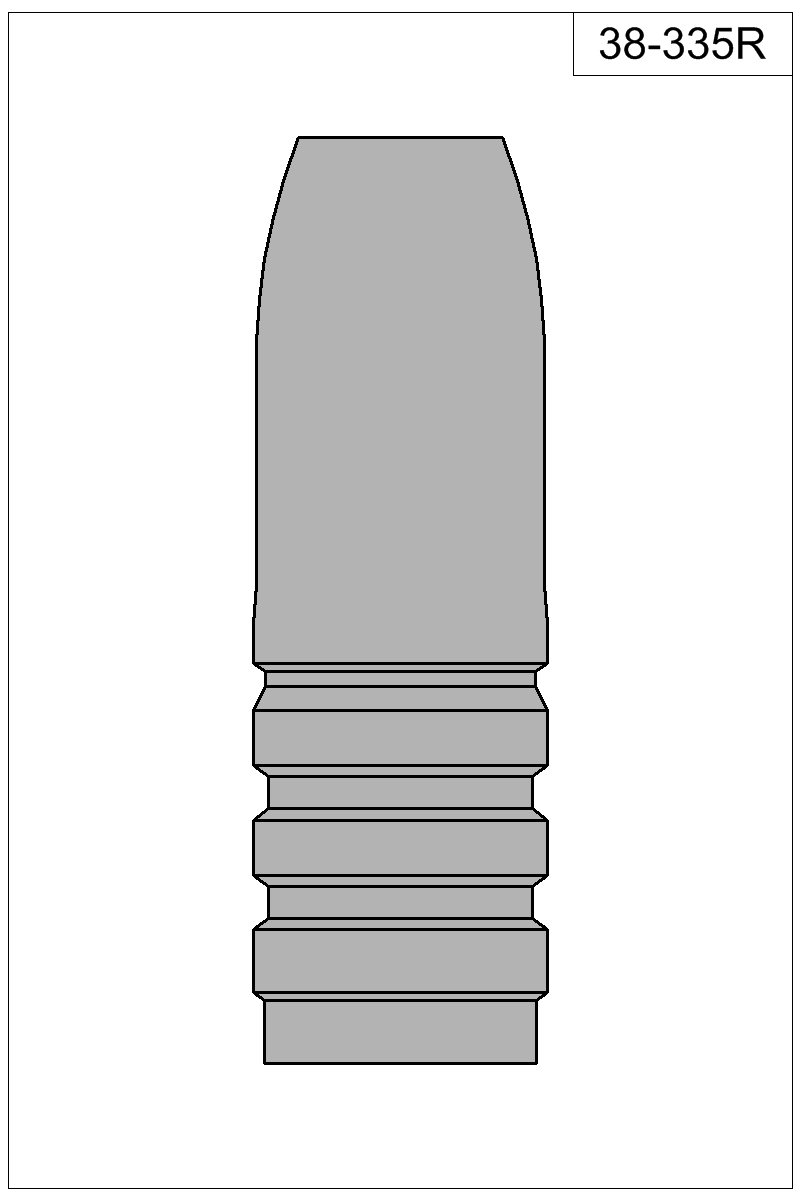
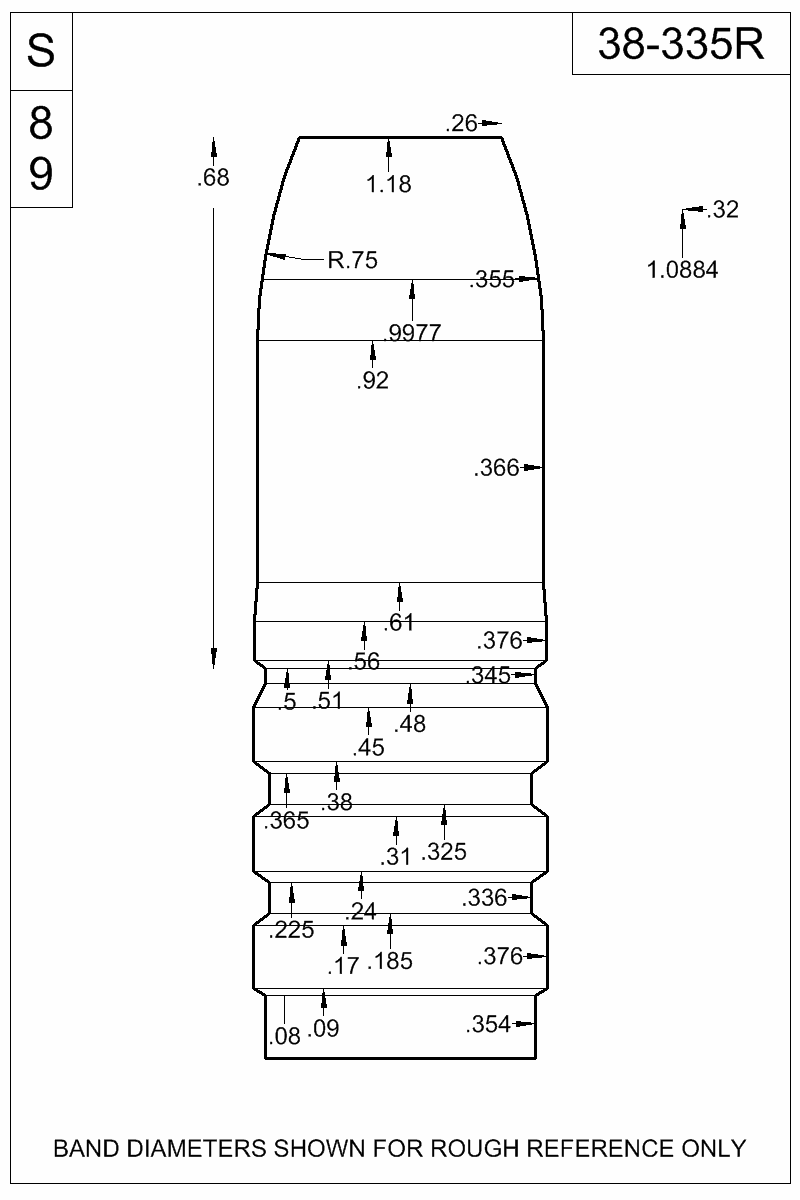
The rendering of the Accurate Molds 38-335R cast bullet design: .382-335 gr FNGCBefore that, though, there were readily available .375 caliber cast bullets to try, notably the Lyman 375449 flat nose gas check design as produced by several casting houses, including Western Bullet Company, Beartooth Bullets (now defunct?) and Northstar Bullets. This bullet was originally intended for the .38-55 WCF, but can be had sized from .376 to .381 caliber and with a weight of 265 grains, it is a good match for duplicating the standard load in the 9.5 x 57 mm. Although, as seen below, these did not quite achieve the upper end of the quoted performance of original loads, they did match the lower end and were a solid 130 fps or so faster than the same loads with a jacketed bullet. This then is an acceptable bullet for the 9.5 x 57 mm, and I experienced no feeding problems with the flat nose. 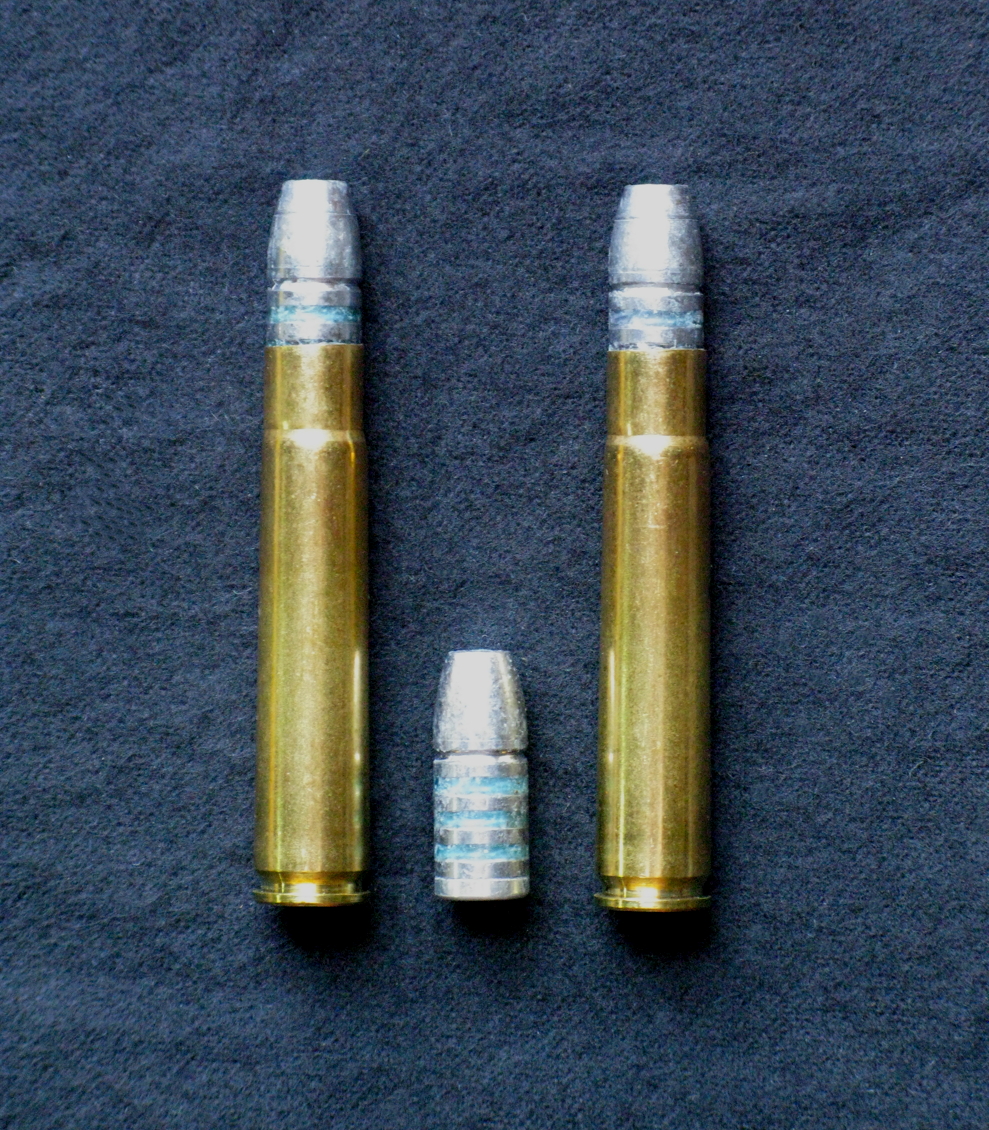
Northstar Bullets .377-265 gr FN-GCUnfortunately, both accuracy and bore leading are an issue for cast bullets that are 0.004 inches undersized. So, I ordered some .381 caliber 278 grain bullets from Montana Bullet Works. These are advertised on the .38-55 page, but are hard cast (BHN 22) and have a gas check. The difficulty with these bullets was that they had to be seated very deeply in the case so that they would not contact the lands of the rifling, which reduced the available propellant volume significantly. They also did not feed well from the magazine owing to the ogive shape and diameter. In a further effort to recover performance lost by the oversized .381 caliber bore, I explored using some .38-55 bullets from Hawk. These were only .377 caliber, but at least someway closer to the proper fit, and I was assured by the proprietor that the soft jackets and cores in these bullets were capable of bumping up as much as 0.003 inches in diameter. Now, I had experienced the bad side of that behavior with my .256 Mannlicher when the bullets were 0.001 to 0.002 inches oversized but when I had tried it with a .312 caliber Hawk in my .315 bore Lee-Speed, I did not get any bump up, although, to be fair, that most likely was because the throat and early portion of the bore is around .318 caliber, with completely washed out rifling, and the bullet probably encountered no resistance on firing. If you look at the load data for the .377-280 grain Hawk FN, you'll see no significant difference in the velocities as compared with the .375-270 grain Hawk bullets. So, I don't think that, even with the relatively thin jacket thickness of 0.025 inches, the .377-280 grain bullets bumped up to any appreciable extent. Certainly not enough to affect performance. Still, the result is not bad, and that is a bullet that will expand readily at these (and lower) velocities. Warning: Use this load data at your own risk. No liability is assumed for the use of this data in any other firearm. It appeared to be safe in the test rifle, but was not subjected to pressure testing. Exercise safe reloading practices. Starting loads should always be reduced by 10% from the maximum load. Table of Load Development Testing
| |||||||||||||||||||||||||||||||||||||||||||||||||||||||||||||||||||||||||||||||||||||||||||||||||||||||||||||||||||||||||||||||||||||||||||||||||||||||||||||||||||||||||||||||||||||||||
The First HuntIn January 2019, my brother, the gunsmith who re-built this rifle from a collection of parts, and I were able to hunt on my cousin's farm in South Alabama on the Macon-Bullock County line. The property is adjacent to and formerly part of one of the largest tracts of hunting land in that region, a fabled estate that still produces excellent deer quality owing the the vastness of the territory and the relatively light (deer) hunting pressure for decades ongoing. I sat on Field No. 3, which lay near the middle of the property on multiple lines of heavy deer traffic. It was bounded by planted pines on one side, an uncut field offering excellent bedding on another, with a hardwood bottom just beyond the pines. My load was a commercial offering by Old Western Scrounger, using a 300 grain bullet with a thin jacket and an enormous amount of exposed lead on its round nose, just like the vintage bullets from the era when this rifle first appeared. I'd give a lot to get access to those bullets for my own reloading but I never could get a straight answer regarding where they came from. Muzzle velocity was a sedate 1800 fps, but that is still comparable to .45-70 factory ballistics, with a bullet that will likely penetrate deeper. 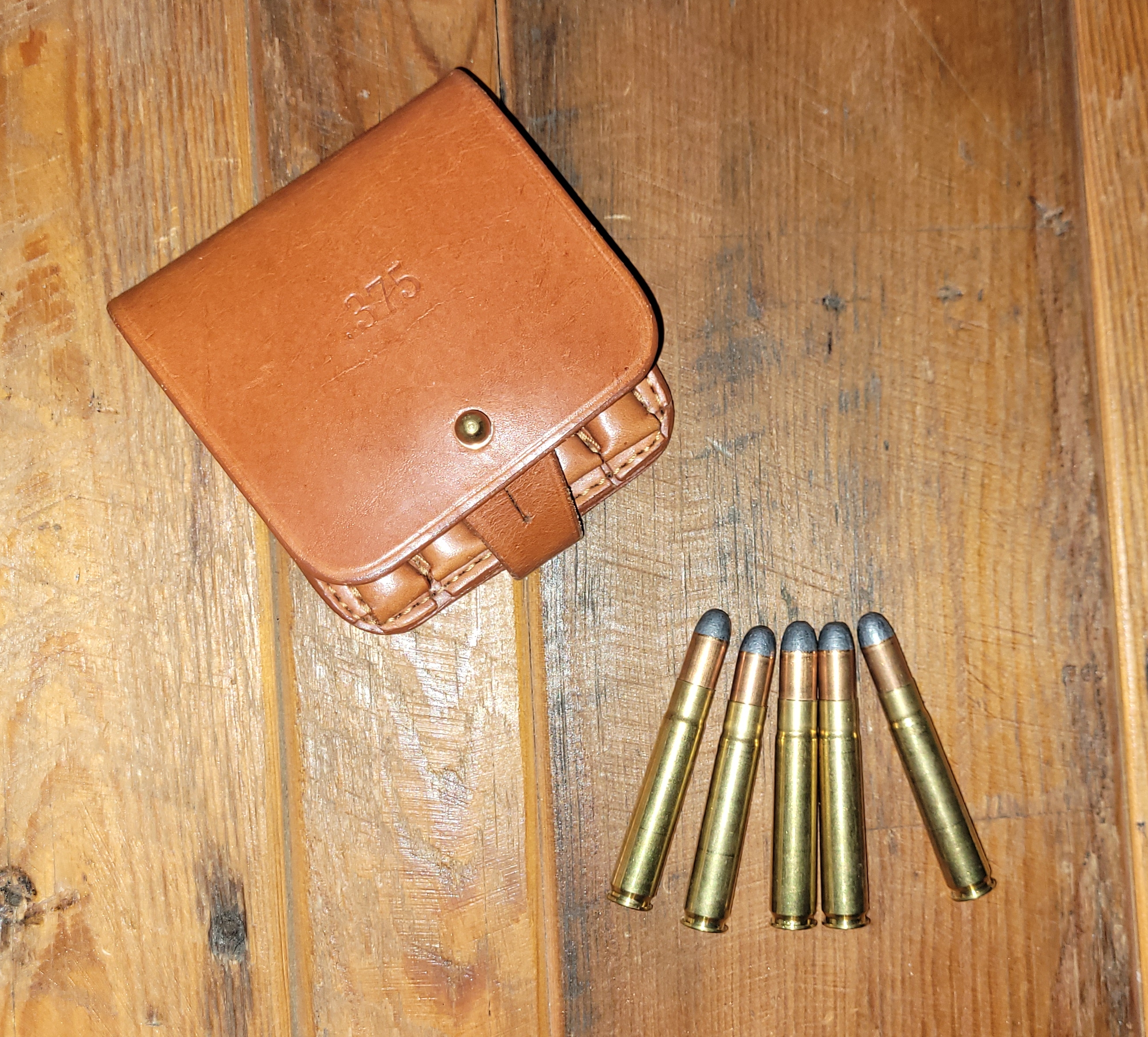
Vintage style 300 grain RN ammunition from Old Western Scrounger with a thin jacket and lots of exposed leadThe buck appeared in mid-afternoon. He was not as large as some that had been reported in that area, but I was not going for the record books, I wanted to kill a buck with this rifle, the old-fashioned way. 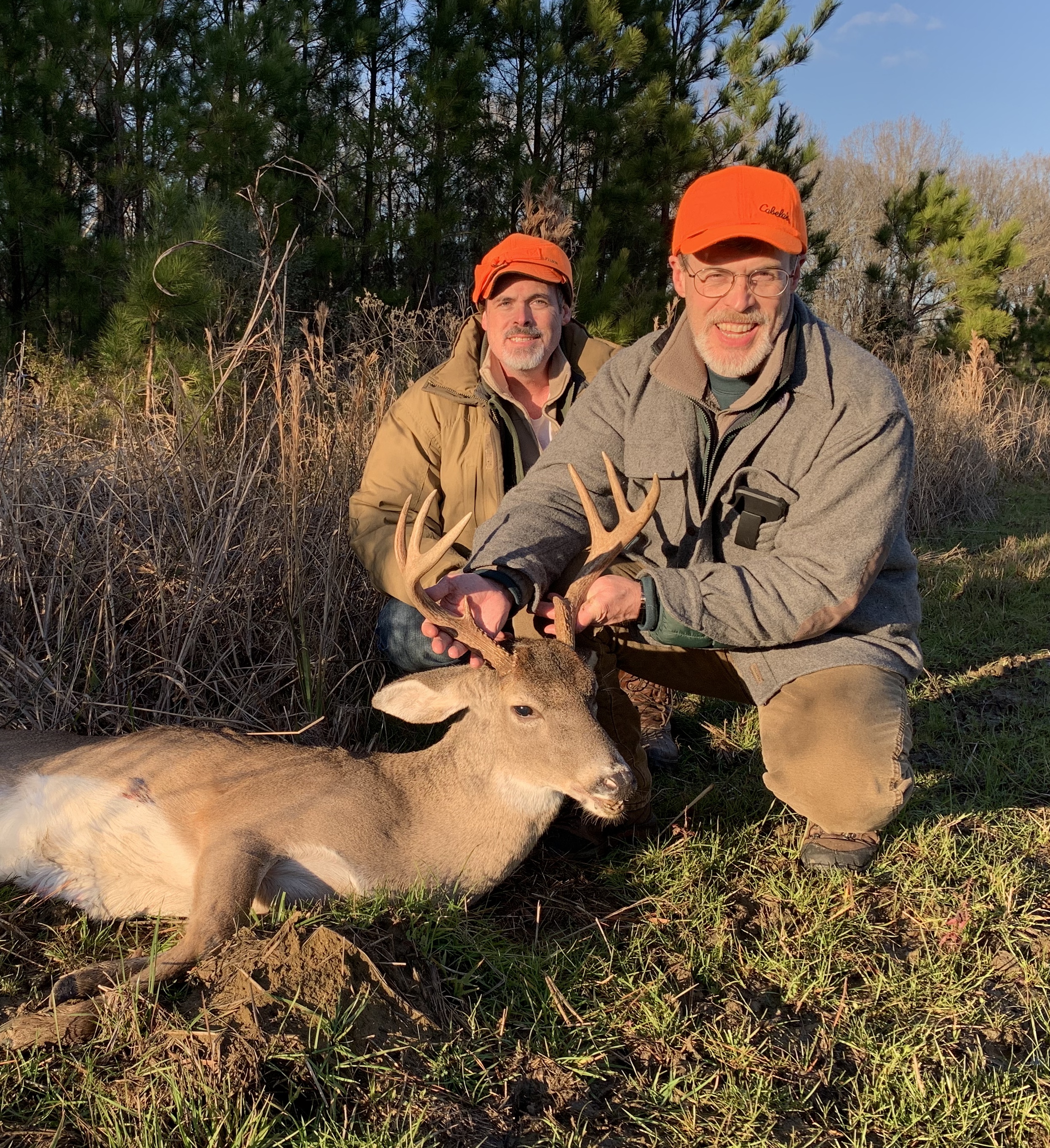
My brother and I pose with the buck I shot on my first hunt with the 1910 Mannlicher-Schoenauer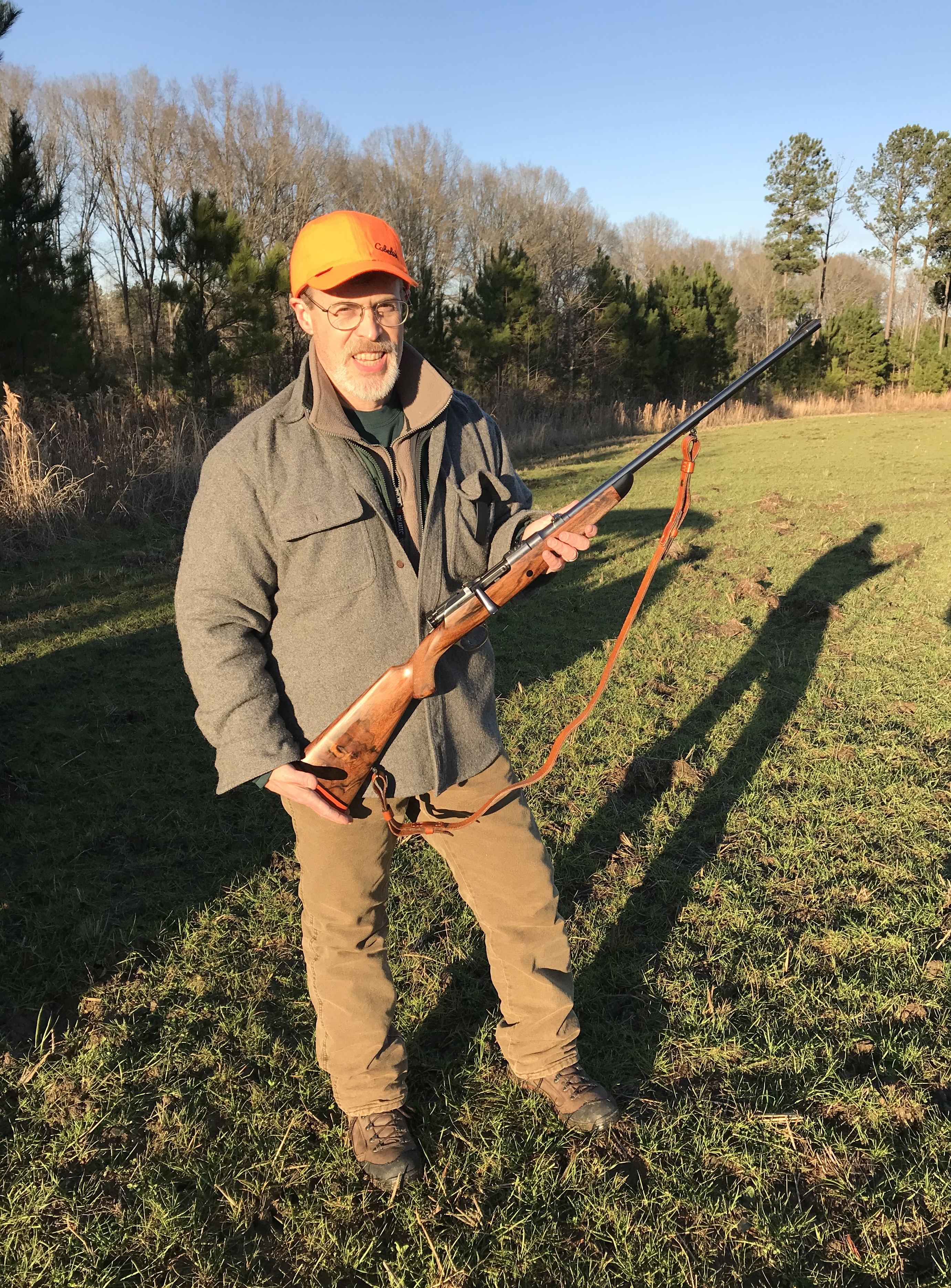
The 1910 Mannlicher-Schoenauer 9.5 x 57 mm still delivers more than a century later | |||||||||||||||||||||||||||||||||||||||||||||||||||||||||||||||||||||||||||||||||||||||||||||||||||||||||||||||||||||||||||||||||||||||||||||||||||||||||||||||||||||||||||||||||||||||||
Return to:
Classic Rifles, Pistols and Cartridges Main PageCopyright 2011 - 2023 -- All Rights Reserved In Memoriam: SHL 1966 - 2020 | |||||||||||||||||||||||||||||||||||||||||||||||||||||||||||||||||||||||||||||||||||||||||||||||||||||||||||||||||||||||||||||||||||||||||||||||||||||||||||||||||||||||||||||||||||||||||